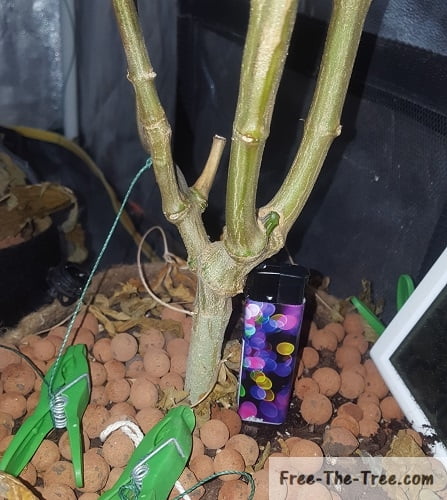Hey there and welcome (back)!
This week was pretty chill, out little laughing buddha is coming along nicely, the Blue Thai is almost ready to get some cuttings done and we make a niiiiice space cake 🙂
Apart from these d**n fungus gnats, really can’t complain! Let’s get into is
Grow report 3 – Table of content
- Laughing Buddha – Growth and Transplantation
- The fight against fungus gnats
- Transferring to the big tent
- Space Cake
Laughing Buddha – Vegetative growth & Transplantation
Vegetative growth
This week our little sprout spread her leaves fully! Our fear of her getting top-heavy didn’t come true, we even set the fan pointing at her for awhile to test her and she stood strong 🙂
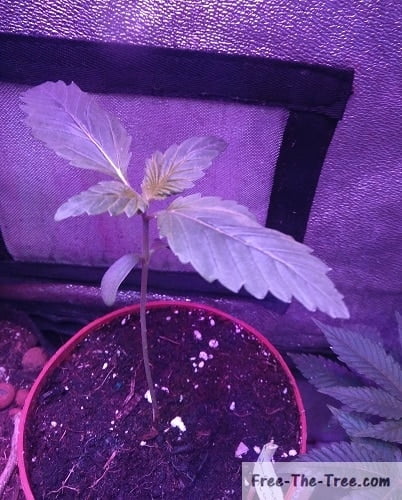
Little one at the beginning of the week
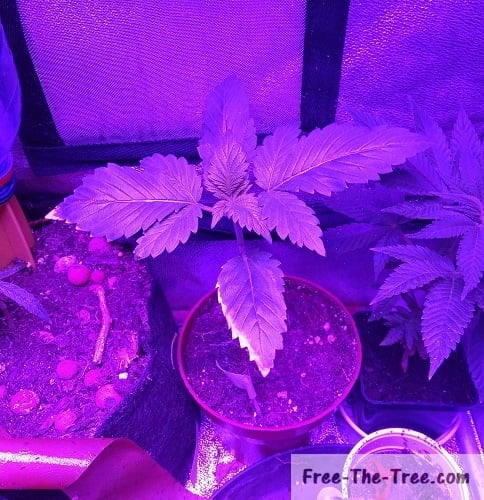
Couple days later, fans leaves well developed
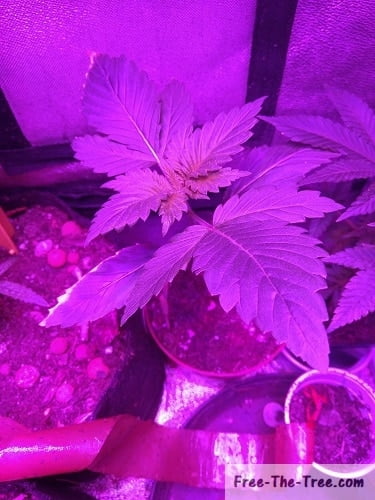
3rd stage growing well – plant starting to lean
First deficiency signs
As you may have noticed in the previous pictures, during the week the little laughing Buddha started showing signs of a deficiency on her first fan leaves.
Pretty sure this is due to the fact that she needs to be transplanted more than a actual nutrient deficiency, sooo let the transplant begin! 🙂
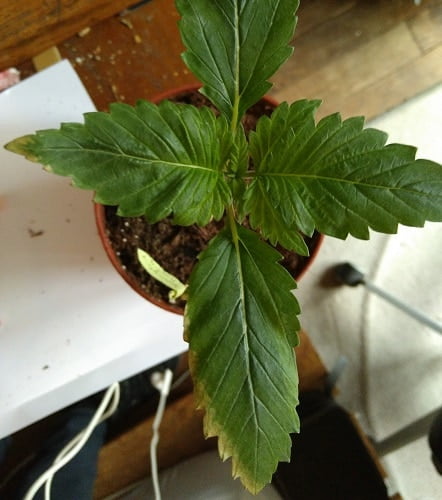
First fan leaves showing deficiency
Transplanting to a 2L fabric pot
As you may be aware, the root mass of a plant is general twice as big as it’s visible foliage.
With that in mind, the pot she’s in is now too small and since it’s made of plastic the roots are most likely spiraling around.
As we started saying above, her first deficiencies are most likely related to this more than any nutrient needing to be added into the soil, although we will start adding some nutrients soon.

Laughing buddha ready to be transplanted
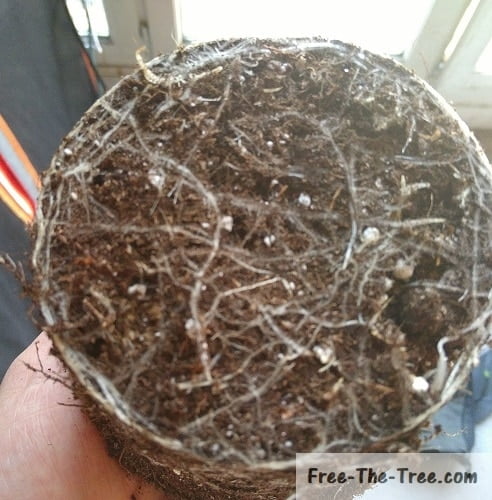
Roots circling in the soil (not good)
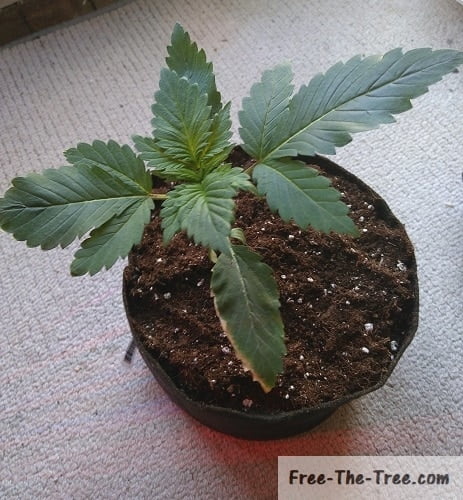
Roots circling in the soil (not good)
We decided to place her into a 2L fabric pot, which will allow the roots to prune themselves, and set her into our main tent, will a 400W LED light system.
The idea is to have her grow quickly, make a couple cuttings and then get her to flower. One of those will be used as a mother, the others will join their clone in the flowering tent 🙂
Fighting off Fungus Gnats
As we pointed out in last weeks grow report we had treated the soil of each pot with a hydrogen peroxyde mix in order to kill all the larvae, the mix being ineffective against the eggs..
Apparently, there were a lot eggs.. as you can see on the image on the right hand side (click to enhance) within a couple days the sticky traps were filled with young fungus gnats.
We’re waiting for a package with some nematodes, gnats natural predators, in order to get fully ride of these sucker..
Hundreds of young gnats on sticky trap
Transferring plants to the big tent
Once we transplanted the laughing Buddha we decided to get the 3 main plants into our bigger room, where the light is much stronger.
Our plan is to get them growing, make couple cuttings, then get to flowering.
With the cuttings we’ll keep one of each to make a mother and the other will meet their sibling in the flowering tents as soon as they’re ready 🙂
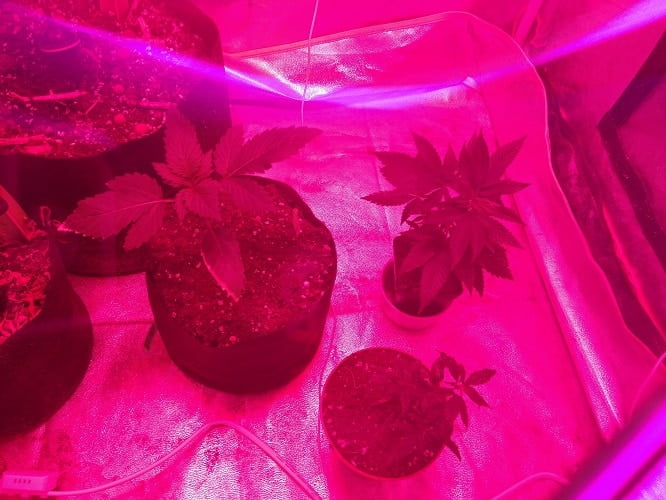
3 plants installed in main grow tent
Space Cookies
If you were with us last week, you’ve followed that we had made some cannabutter; now it’s time to take off.
We used Flo’s famous chocolate cake recipe (;p). Butter wise, to be fully honest, we have noooooo idea of how potent it is, so we’ll find out.
Here’s the ingredients and so pictures to end this post in a tasty manner
Space cookie ingredients (2 cakes made)
- 480g of cannabutter
- 400 of dark chocolate (the cooking kind!)
- 8 eggs
- Sugar
And that looks liiiiike :

480g Cannabutter

Chocolate and Cannabutter heating up
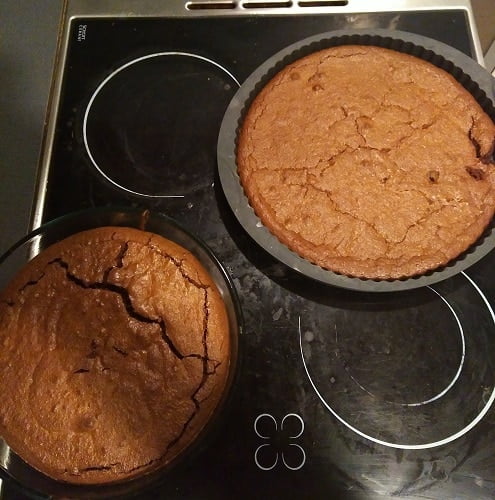
Space Cake out of the oven (wish you could smell em)
Alright got some cake to go eat hehehe
Until next week,
be safe and grow easy 😉
EDIT: that butter was pretty potent, got way too high
Hey there and welcome (back) ! 🙂
This past week was a pretty eventful one, these little ones needed a good amount of attention, which we were happy to provide hehe
As always, before we get into it, here’s a little overview of what we’re going to cover
Grow Report 2 – Table of content
- Laughing Buddha – Early stretch & first leaves
- Critical+ Cuttings – Transplanting and fungus gnats…
- Makin some cannabutteeeer 🙂
- Blue Thai Mother – First cutting
Don’t hesitate to skip ahead if you want, for the others let’s get into the Laughing Buddha, she’s scaring us a baby bit
Laughing Buddha – Early stretch & First leaves
Growth of the first leaves
If you’ve checked out last weeks grow report you’re aware that this little one had just broken ground and spread her cotyledons by the end of last week.
Within 2 days she started growing her first leaves which is pretty awesome 🙂 really want her to get growing quickly so we can make some cuttings and flower them asaaaap

Growth of first leaves
Seedling stem stretching too much
As you can see in the image on the right the stem of this little one is pretty long, showing that she’s not receiving enough light, thus reaching for it.
This is really no optimal, appart from the fact that she’s focusing on vertical growth and not developing foliage (leaves) she will most likely be top heavy once those leaves do start to grow..
This is something we’ve experienced a couple grows ago, and covered a previous grow report.
It’s not the end of the world if she does get top heavy, we’ll give her a crouch until the stem gets strong enough to for her to stand.
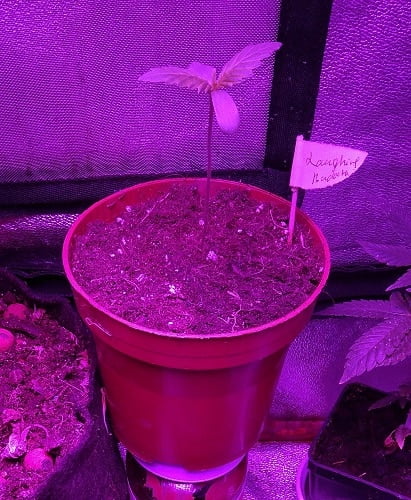
Plant place closer to the light source to avoid any more stretching
Growth of the second stage of leaves
This little one is a fast grower, the first stage of leaves had hardly grown that she was already sprouting the second one.
She’s really looking good, still a bit worries about her balance, when we watered her she wasn’t holding up all that good.
We’ve also added [a much needed] fan in there to get some wind blowing, which will make her develop the stem much more, as well as help dry up the soil after watering, avoiding these damn fungus gnats (getting to that next)
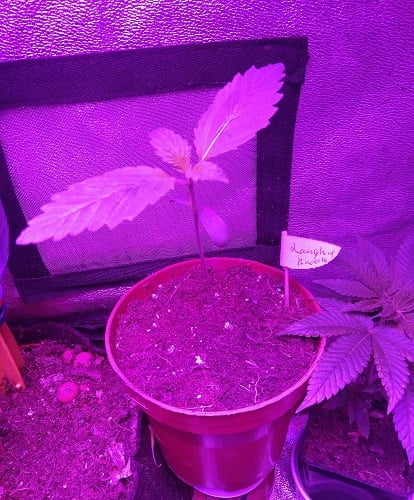
Second stage of leaves growing
Critical+ Cuttings – Transplanting and Fungus gnats
Transplanting the Critical+ plants
Although it was a bit early to do so, we decided to go ahead and transplant the plant that’s going to stay in the vegetation tent as a mother.
For the the 3 other ones we’re going to wait until they grow a bit more than transplant & flower them right away, can’t waiiiiiiiiiit 🙂
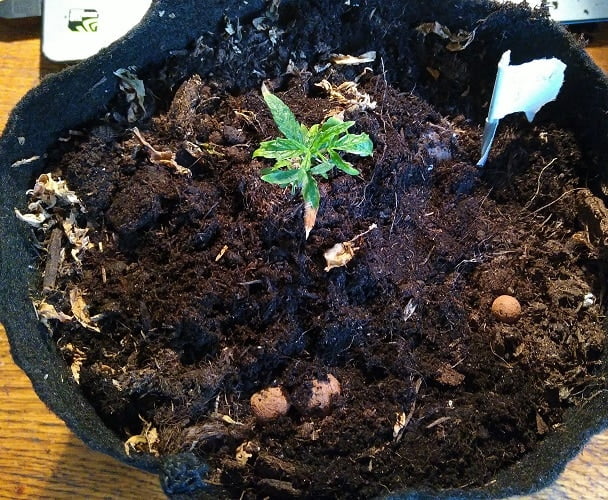
Critical+ transplanted to a 2L fabric pot
Dealing with fungus gnats
After thrips and spidermites here we are dealing with fungus gnats… haven’t signed up for pests control school, but we’re getting close to being experts here -_-“
We had been wondering why our little cuttings were growing so slowly and with unhealthy looking foliage; turns out, it’s linked to the fungus gnat larvae feeding on our babies roots..
We’ll do a full “how to” deal with fungus gnats soon, but basically here’s how we’re dealing with them :
- Sprayed the soil with a mix of Hydrogen peroxyde (1/4) and water (3/4).
This kills the larvae, but doesn’t deal with the eggs or adults - Manually hunted the visible adults
- Set a fan out in order to dry the top soil (fungus gnats need humid soil)
- Put down sticky traps for the adults. This doesn’t seem super effective atm, we’re going to lay out a glass with a little beer for them to drown in (follow a tip through instagram)
Next we’re going to remove the top 3/4cm of soil in order to get any and all eggs out of there, and possibly buy some nematodes to get this soil living with healthy organisms.
Hopefully this is going to be the end of that..

Fungus gnat damage visible on the foliage
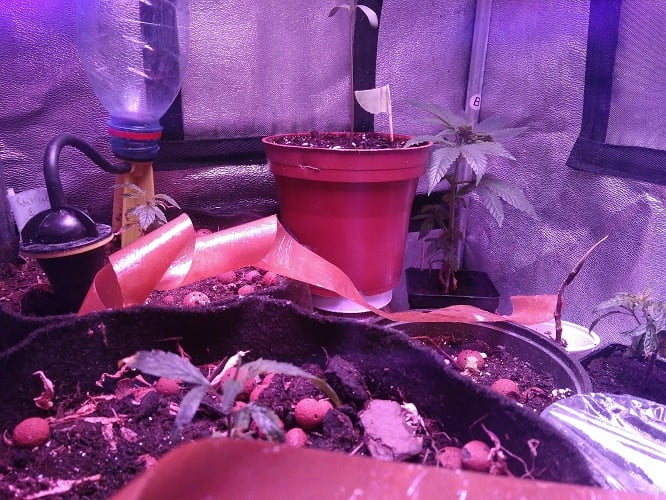
Fungus gnat damage visible on the foliage
Makin’ some cannabutteeer
We had been putting it off for awhile but finally got around to making some cannabutteeeer!
Been saving up the trims of the past 5 grows so really exited to see what it’s going to turn our to be hehehe.
We’re not going to detail all the steps here, if you’re trying to make some check out our recipe over here, that said here’s a couple pics just cause 😉
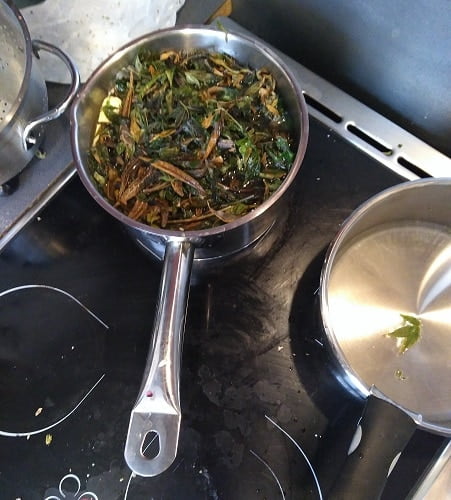
Leaves&Butter chillin in water
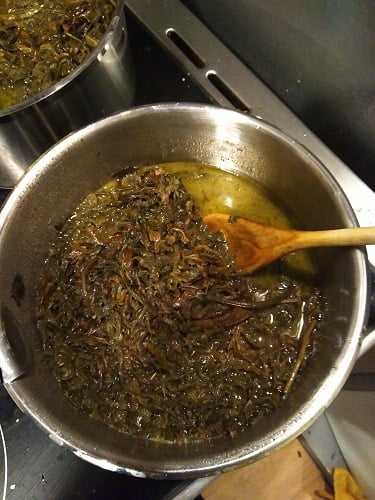
Leaves&Butter chillin in water
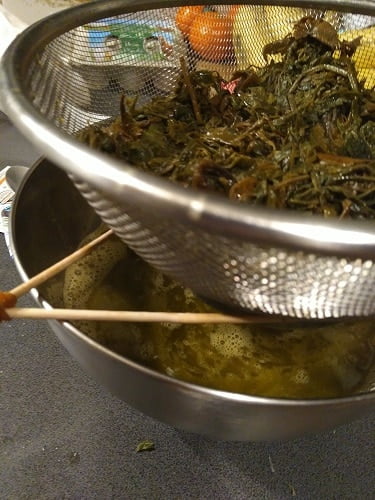
Straining the water&cannabutter mix from the leaves
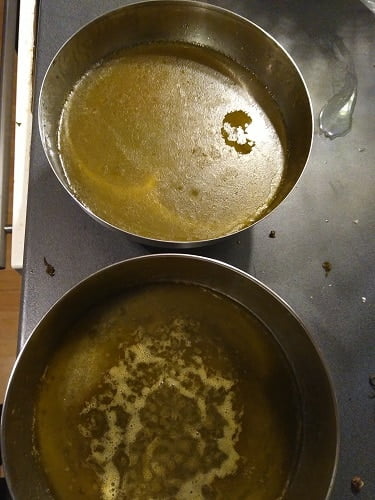
Cannabutter&Water
ready to cool down
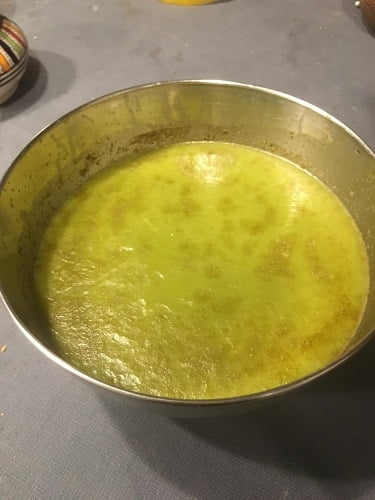
After 24 hours in the fridge,
cannabutter is solid.

Water poured out leaving the cannabutter ready for cooking! 🙂
Blue Thai’s first cutting
Since we don’t want to flower our last blue thaï plant, we’ve decided to keep this one as a mother and flower some cuttings. Thing is… i’m not super super patient (workin on it ^^), and want to get her into the flowering tent asaaaaap.
In that spirit, I looked for a nice little side branch big enough to make a cutting out of.
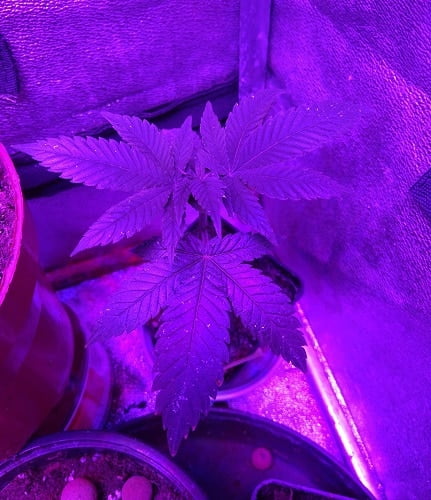
Blue Thai mother plant
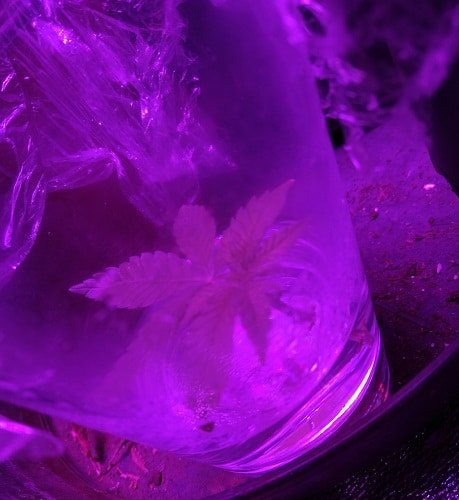
Blue Thai mother plant
As you can see, we spotted one that was small, but not too small, and went for it. Hopefully, since it’s such a young sprout, it’ll still have a bunch of rooting hormones and will take quickly.
In order to keep it in a nice, humid, environment we placed it in a glass of water and placed cellophane over it, with a couple whole.
Water droplets quickly formed on the sides of the glass, showing that humidity levels are high. Hopefully she’s going to take!
Alright folks that’s all for this week,
Until next time, be safe and grow easy!
P.S: if you want to keep in touch, come say hi on our insta 😉
Hey there and welcome (back) ! 🙂
Here we are, back at the beginning of a cycle! Can’t wait to share these upcoming weeks with all of you
Couple changes since last grow, so to start off clean here’s a recap of the strains and equipment we’re using
Grow Report 1 – Equipment & strains
- Strains: Critical+ (cuttings) & Laughing Buddha
- Seed Type: Feminized
- Seed Bank: Barney’s Farm
- Nutrients or Additive Used:
– Bio Grow NP and PK mixes
- Grow Lights:
– Vegetation Stage : 75W LED table
– Flowering Stage : 400W LED table - Grower experience: 6th grow
Alright, now that that’s out of the way, let’s get into the first steps of these little one’s lives 🙂
We’ve divided this article in 2 sections starting with the cuttings and end with the seed germinating
Critical+ Cuttings – Rooting process
As some of you are aware we’ve had a critical+ mother plant for a little while, this is our 3rd round of cuttings with her.
Here’s a couple pics of the process but, in full honesty, we slacked off a little and left them in the cups for too long, which made us lose 2 little ones and a bunch of time. If you want to know more on how to make a cutting, check out our how-to article over here 😉
Picking and cutting the branches
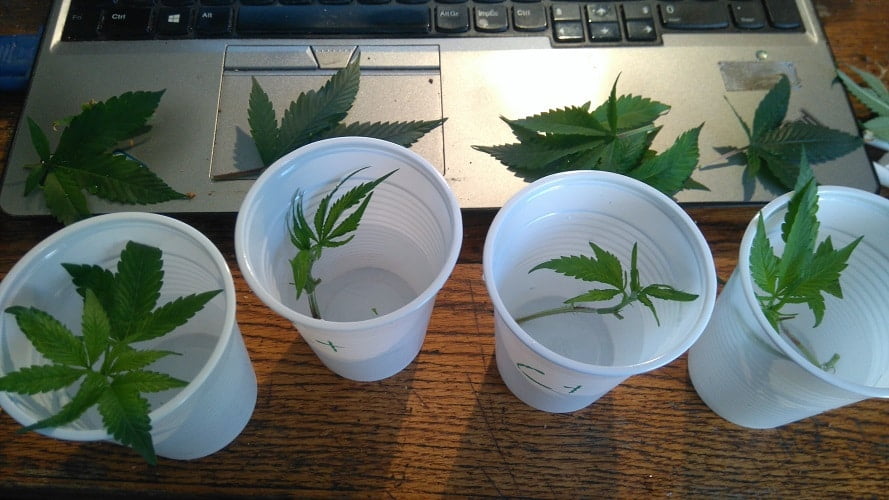
The first step to making the cuttings is obviously picking and cutting the right branches from the mother plant ^^
This round we started with 7 branches, planning that we would lose one or 2.
As we detail in our how-to article on making cuttings, the branches don’t need much light in order to root, what they do need it NOT to sweat, so don’t hesitate to chop off most their leaves (the left one still has way too many leaves) and place them in a very humid environment (aim for at least 90% humidity).
Cuttings rooting in the vegetation tent
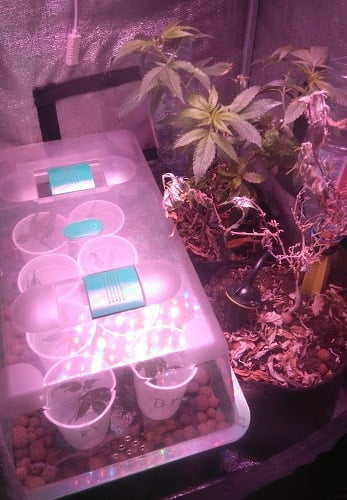
We left the little one in the cups of water for about a week, the time for some roots to grow.
At this point we lost one of the little ones, we had left the top latch open, it wasn’t humid enough and she didn’t make it… (told you we were slacking off :/)
As you can see on the pic one of our mothers isn’t looking well at all, all dried up and dying… We were so focused on the citizen lobbying tool that we didn’t water her enough and lost her :'(.
Passing the cuttings from water to soil
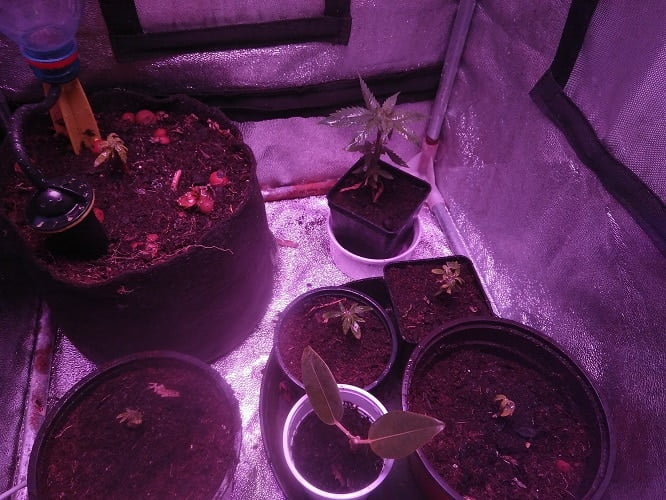
Once we had some nice roots we went ahead and transferred the cutting into our pots.
As you can see we have them in different size pots. The idea here is to keep one as a mother plant (top left). The 4 others we will re-pot and transfert into the flowering tent once they’re ready to stretch.
(Yep, we lost another little one between the 2 steps… we took wayyyy too long to transfert them into the soil)
That’s it for these little ones! As we speak they’re getting growing nicely, but we’ll tell you all about that in the next post 😉
Laughing Buddha Seed Germination
Here’s a little one we’re really excited about! First time growing it and really curious to see what it’s all about.
For a long time it was a best seller at Barney’s Farm, a coffee shop & seed bank in the Netherlands although now, unfortunately, a bit it’s harder to find these days.
Luckily, during our last trip in Amsterdam we were able to get a little seed! 🙂
(check out the trip on our insta account)
Alright, enough said, here’s some pics of the germination process of this little one
Seed Germinating – A humid and dark environment
Just like for the cuttings, we’ve made a full how-to article detailing the best ways to germinate your seeds, if you want to know more on that check it out over here

We set the little one in a humid paper towel between two bowls. At first it was wayyyy too humid in there, so we left a little crack between the bowls in order to let some humidity out.
5 days later, the tap root has broken the shell
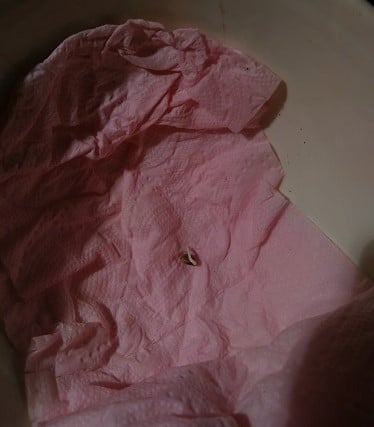
The morning after leaving the crack between the bowls we saw the tap root starting to break the shell; The picture above was taken that night and, as you can see, it’s big enough to plant 🙂
Seed you soon cotyledons 😉

With the tap root about a centimeter long we planted the soil, about 1.5 cm deep. This depth gives it enough room to break soil and deploy the cotyledons with little effort, while the tap root can get comfortable in her new home.
As soon as we covered the seed, we set the pot in a bowl of water in order to humidify the soil without disturbing the seed.
48 hours later – Soil has been broken and the cotyledons deployed
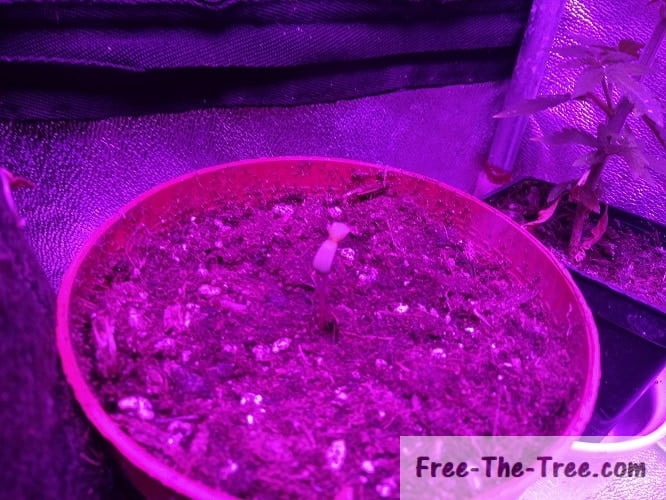
A little under 48 hours later she had broken the soil and deployed her cotyledons and, you can’t really see it but, the first leaves are starting to grow.
We actually missed the ground breaking process which sucks… so awesome to see ’em say hello to the world for the first time.
As we speak the first leaves are starting grow more and the cotyledons are starting to die out; We set the pot on a box in order to get the Apex closer to the light in order to avoid any early stage stretching, we don’t want her to get top-heavy ^^
Alright folks, that’s it for this one!
Until next week, be safe and grow easy 😉
Hey there !
Wish we were writing this post on a happier subject… But for the past couple months we’ve been battling a spidermite invasion, and what a battle it’s been !
The infestation started in our little garden, on our tomatoes to be specific, but with time these suckers spread… Outside they got to our a bunch of our plants and while we were busy raising money for citizen lobbying tool these suckers got to our flowering tent…
Let’s go over this whole o’deal together 😉
Excuse us for not having the best quality pics available on this post, our camera broke and we haven’t been able to replace it yet
The first signs of Spider Mites…
As you’re most likely aware, spidermites reveal their presence by leaving little white spots on the leaves. If you’re seeing this, ACT NOW, the earlier you start fighting back the infestation the better your chances are.
On our end when we noticed we had just gotten back from vacation so the infestation was already massive.
The image below shows a couple leaves totally infested. The plant was over 4 feet tall, just imagine how many individuals were on there..

Every red dot… is an adult spidermite
Our first strike – Black Soap & Neem oil Combo
Since we already had dealt with a thrips invasion during our previous grow (yeah, we’re not lucky), we already had black soap and neem oil around.
These 2 ingredients work just as well as on Spidermites as they do on thrips, on paper. As we cover in our guide on how to deal with spidermites, the importance here is coverage, coverage, coverage.

Our neem oil & Black soap mix ready we started spraying all the infested plants, making sure to cover as much the top of the leaves and their backside, where the mites lay all their eggs.
The spidermites strike back, viciously
After applying the mix all over the plants, twice, leaving a couple day intervals we had to leave for a couple days again.
When we came back these suckers had come back too, and with a vengeance! Honestly I think there were thousands of them on just this one tomatoes plant.
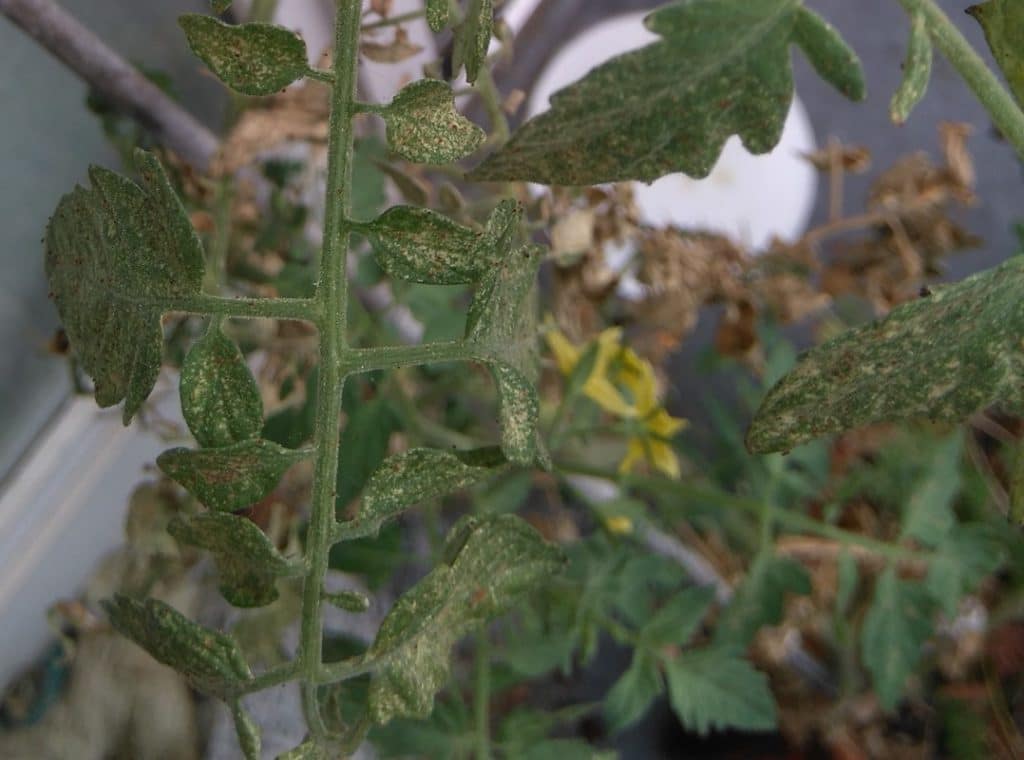
click on the image to get the full view, and again every red dot is an adult spidermite…
At this point it started really impacting the development of the plant with some sections totally dying out (the ongoing drought didn’t help out).
The fruit bearing sections went from 12 flowers to 2/3 per ramification, new growth slowed crazily and older sections started dying out.
Clearly, these pest don’t hesitate to suck the live out their host, literally.
Nature does things well… Investing in Predators
The Neem oil and Black soap mix is effective against the adult mites but I’m not so sure about their eggs, and since they can lay up to 20 of them a day, the adults are really just the visible part of the iceberg.
That’s where investing in a predator is useful, in our case we’re talking about the Phytoseiulus Persimilis, which feeds exclusively on spidermites and their eggs !
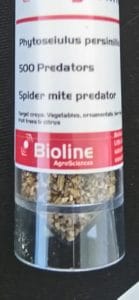
The number of individuals you want to get will depend on the size of your infestation, on our end with 500 we clearly under did it since we had about 6 infested plants by the time they got here.
As we point our in-depth article on spidermites, linked above, applying a round of neem oil & black soap mix a day before introducing the predators.
In doing so you will reduce the number of pests drastically, and then the predators will swoop in to finish the rest of the adults and eggs that are still around.
Not enough predators, the mites spread to the Cannabis plants
By now it’s been over 2 months since the first signs of the pest and they started infesting the flowering plant mid-way through the flowering phase.
The worst part, we were in the middle of the crowdfunding campaign with United4Earth so let’s just say that we weren’t the most attentive to our babies at that moment…
The mites had fully infested our Blue Kush by the time we even realized they were around.
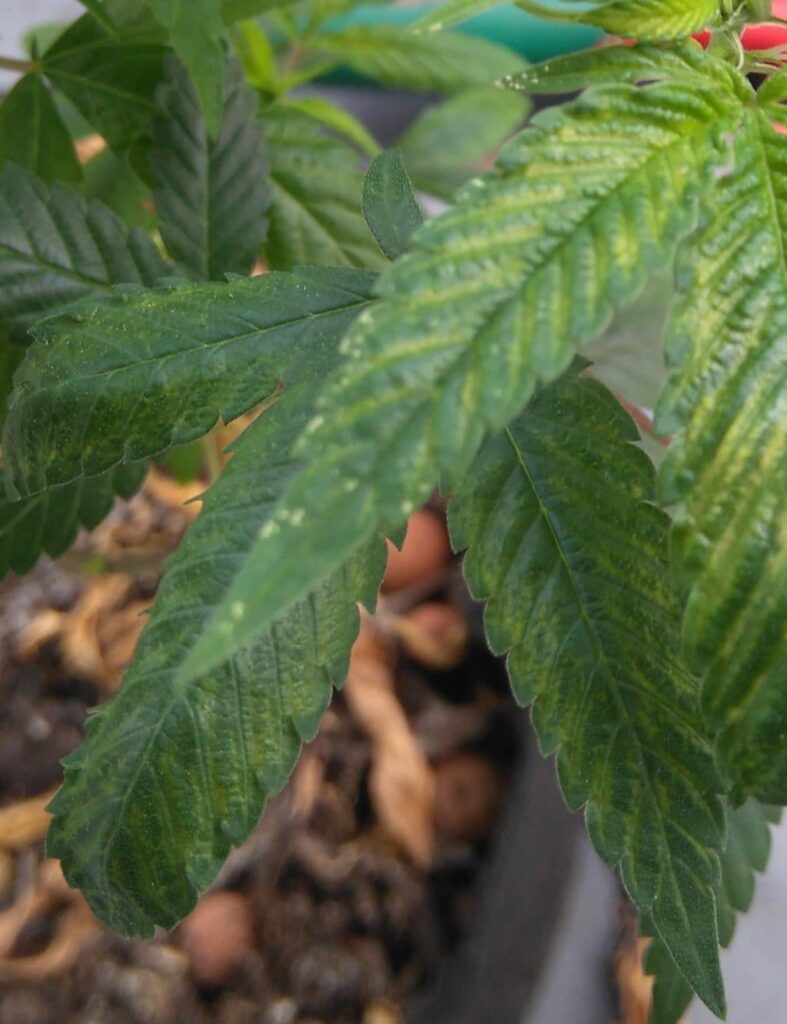
First white marks appearing on cannabis leaves
As you can imagine, we were unhappy of this discovery, to say the least. Here we were, back preparing a mix and ordering some predators, again…
Since we were in the flowering phase we just used the Neem oil the first time, as ingesting it can get you sick, so we didn’t want it all over the buds we were going to smoke.
A very weak harvest..
Every couple days we kept spraying the foliage, but there was so much damage done that we decided to go ahead and harvest, clean the room before placing the rooted clones into the flowering tent.
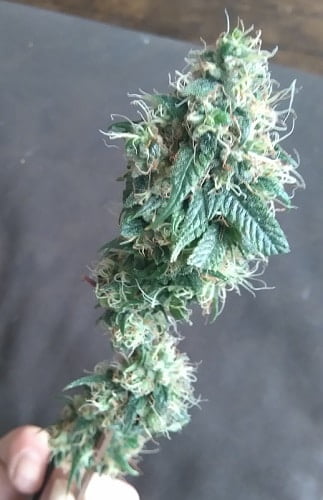
Critical + Apex bud freshly harvested and pruned
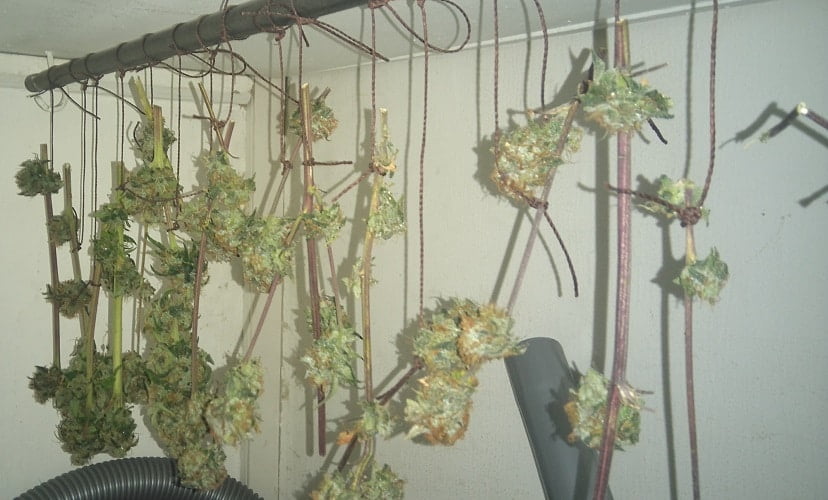
2 plants drying – Super small harvest
Just as we saw with the tomatoes, since the plants were battling for survival, the amount of flowers produced was severely impacted. We haven’t weighed it out yet but i’m thinking it lost us at least 50% of the harvest..
Hopefully our in-depth clean of the grow room got rid of the last suckers, but just in case we still have that batch of predators that should be arriving soon. We will introduce them in the grow room regardless so that they can go hunt for eggs.
We don’t wand to get a surprise in a couple months when the ones laying around start hatching.
That’s it for this one ! Hopefully this will be our last post regarding spidermites (and thrips)
We’ve decided to start posting an article every friday from now on, so until next week,
Be safe and grow easy!
Hey everyone ! Long time no see…
We really haven’t been active on the website these past 2 months but we haven’t been off !
Although most our visible activity has only been on the Instagram account we also partnered up with United4Earth in order to group forces and fund the citizen lobbying tool.
We’re proud to announce that a couple days ago the crowdfunding campaign ended successfully, raising over $11.000 with 525 participants! 🙂
25 days of Crowdfunding on Ulule
The crowdfunding campaign lasted a little under a month and was, the least to say, intense.
United4Earth was mainly focusing on France for their efforts since there’s a rise for climate going on for the past couple months, most of the events went on overthere.

The 10.000€ needed to fund the first version of the tool was reached on Monday the 15th of Octobre, a couple days before the end of the campaign. By the time we reached the last day we had passed the target by over 1500 euros !!
What will the tool look like?
If you’ve followed us on Instagram you may have already seen some videos or screenshots of what the tool would look like.
Since then, things have evolved a bit, but the concept is the same ! Here’s a quick video that shows a citizen of South Carolina using the tool on United4Earth.
Get the concept? We’ll be able to do the same for Cannabis legalization on free-the-tree.org !
When can we start the citizen lobbying to legalize cannabis?
Now that crowdfunding campaign is finished the developers have started working on the project. The goal is have the bêta of the tool up and running on United4Earth by the end of November 2018.
We will need some time to test the tools and fix the bugs that will show up. With that in mind, the idea is to open up the tool on the subject of Cannabis between January and February 2019!
Want join the community now?
Hi there and welcome to the last grow report of the series!
If you’ve been following these, sorry for the time it’s been since the last report, we’ve been working hard on getting the Price and Strain comparison tool usable and on the (soon to come) crowdfunding campaign!
We want to get the V1 of the Communities Lobbying Platform up and running by September 🙂
Let’s get back to the grow report though: this past month has been pretty full of events, we had time to harvest, dry and start curing the buds and even smoke a little since the last grow report!
In total we harvested about 250g of dried buds, pretty happy with it, but it’s not to say we didn’t make a bunch of mistakes along the way.
Let’s get into these last steps of our babies lives:
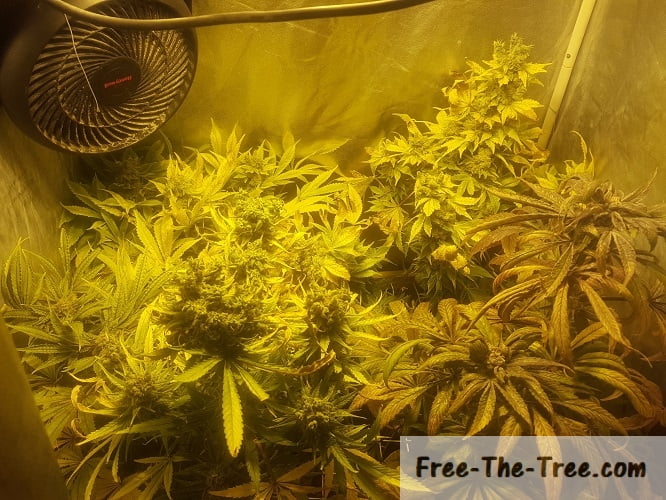
Grow room at the beginning of the Week
The Last Week – Harvesting Gradually
Since we had different strains in the front of the room, and couldn’t get well enough to into the back to be sure for the Big Buddha cheese plants we decided to harvest gradually over the course of about 10-15 days (started in previous grow reports).
Harvesting the Big Buddha Cheese Plant
We really had about 3 rounds of harvesting over the week with the BBC, first we cut a couple buds then went for the finish.
As they say, a picture’s worth a thousand words, so here’s a couple thousand words worth of bud harvesting :
Round 1 & 2
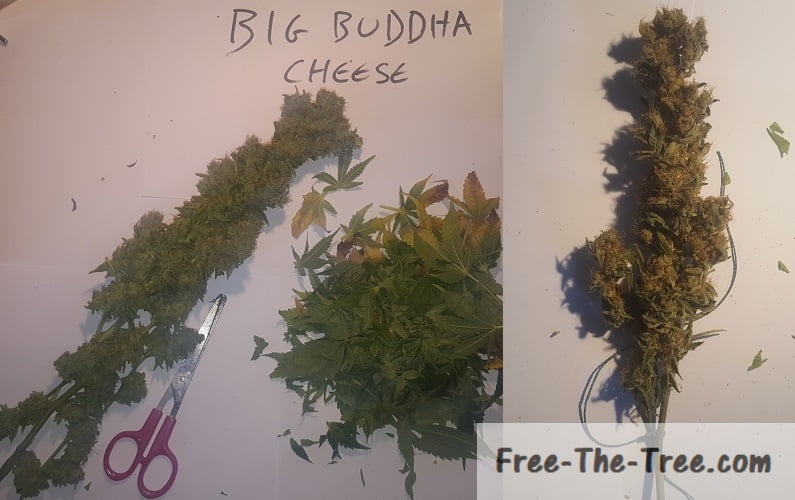
Buds harvested at the beginning of the week

Colas harvested a day or 2 later – Before pruning

Bud After Pruning
Here’s a quick picture during the middle of the week, these are all the first BBC buds and the Cheese plant drying.
After this pic some of the buds were ready to get into the jars to start curing.
Curing enables the buds to continue drying slowly. It’s really important as it helps remove the moisture, affecting the potency of your plant. Check out our full article on curing.

First Buds Drying in a Dark Area
Main Big Buddha Cheese Harvest
Let’s get to the real harvest for the BBC, took us about 4 hours to clean up all the buds and get them to dry. Takes a lot of time to get some nice, tasty, flowers in the end

Flower before pruning the leaves
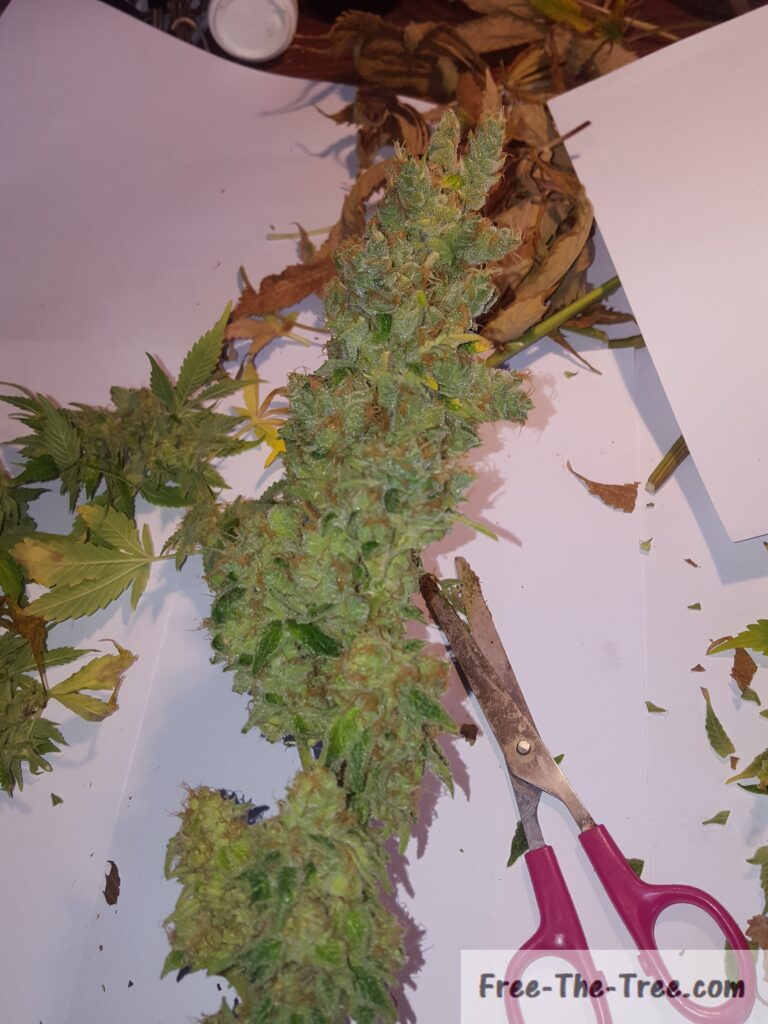
All leaves removed, ready to dry

Light Exposure during Night Hours created some funny looking Apex’s
Light Exposure during the Flowering stage
This is something we hadn’t really covered since I thought it was linked to the Calcium deficiency we had. After talking with a friend she shed some light on this.
See that picture above on the right? How the flowers are growing in separate ways instead of forming the usual, cone-like, flower? This is linked to the fact that light must have been leaking into the grow room at night, stressing the plant.
Let’s get back to the Harvest 🙂
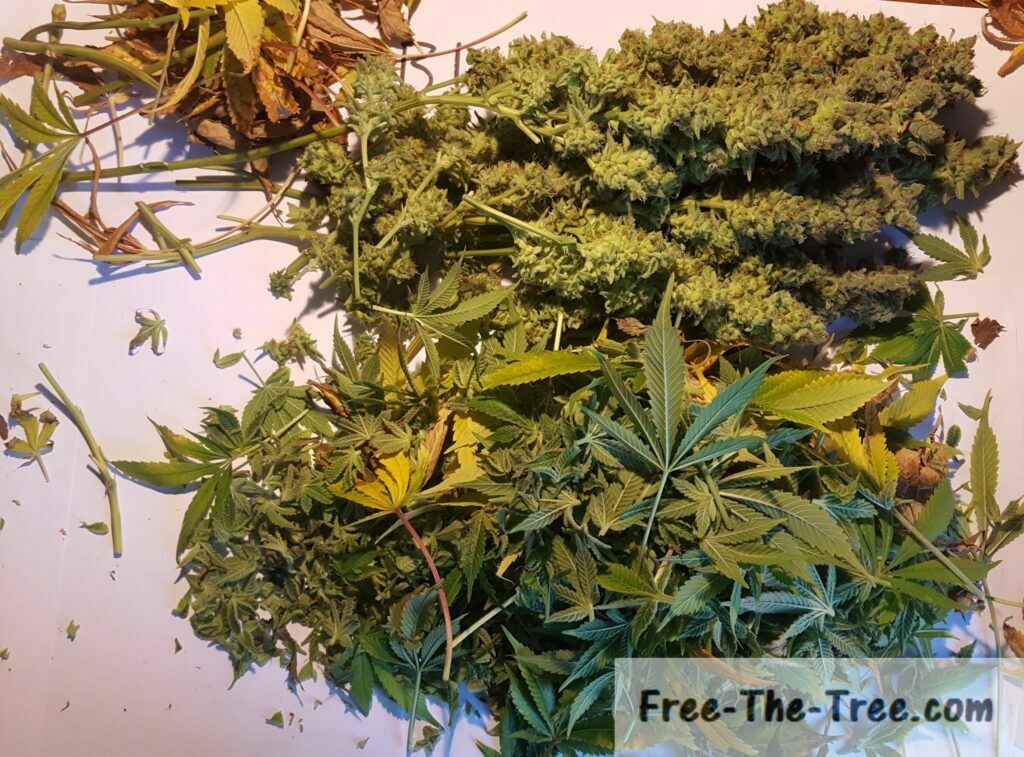
Stack of harvested BBC Buds and Leaves
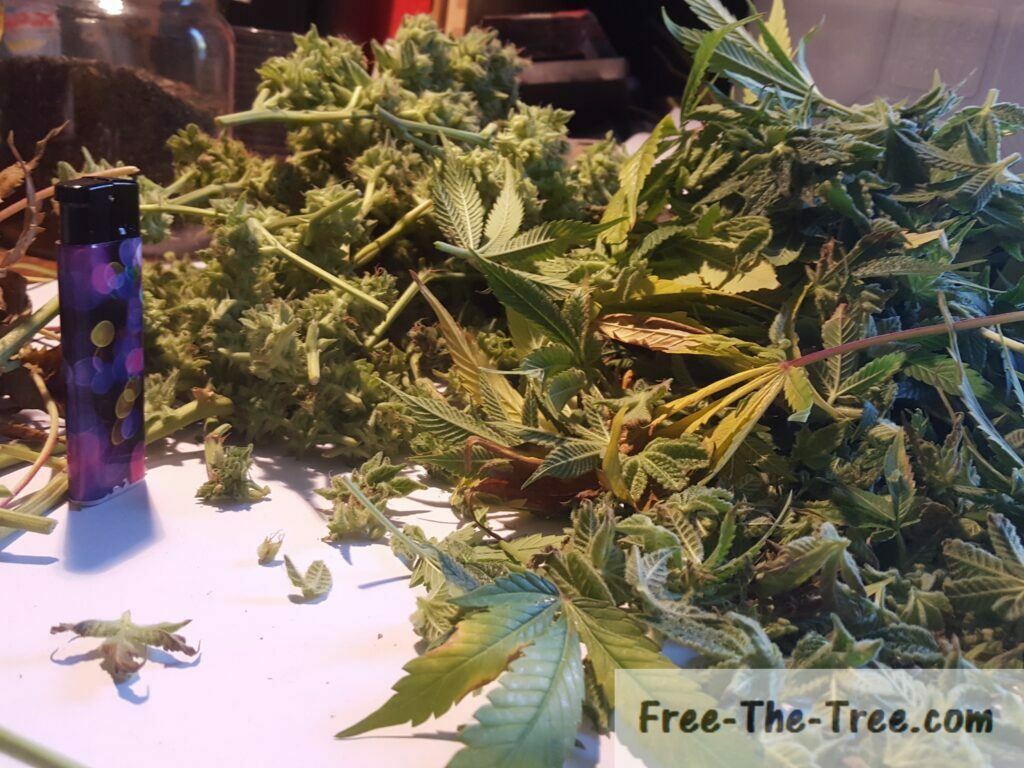
Horizontal view of the stacked buds
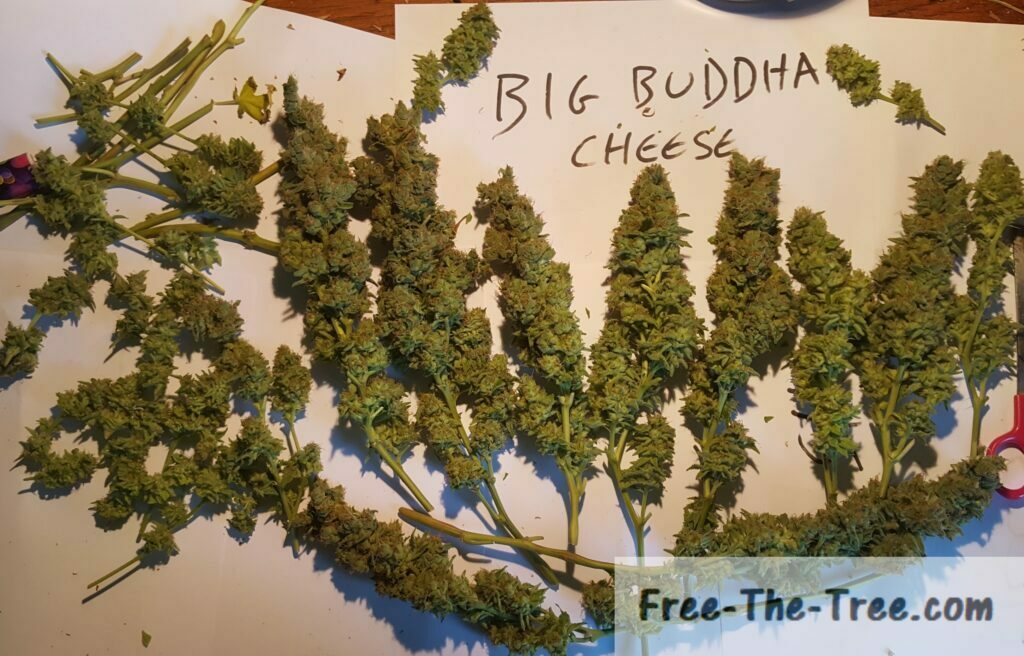
Main BBC Harvest – 10 to 15 Colas ready to dry
Once all the buds were nicely pruned, we attached a string at the bottom of the stem in order to hang them up side down to dry for about 10 days (until the moment where, when folding the stem, it cracks, without breaking).
Harvesting the Cheese Plant
Our Cheese plant really was a tree ^^ Appart from topping her about 2/3 weeks ago due to her height we harvested her at once, her trichomes were nice and milky, think it’s one of the ones we timed the best.
Her’s what she looked like out of the grow room (as always, click on the images to have the full view)
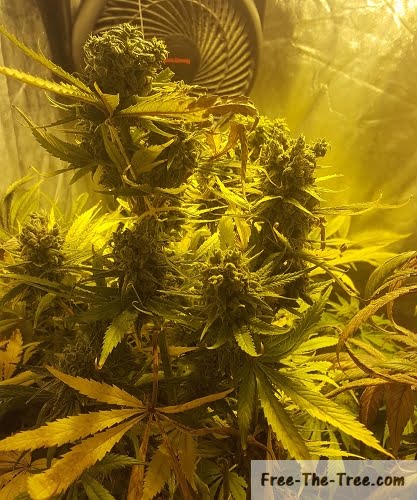
Cheese before harvest
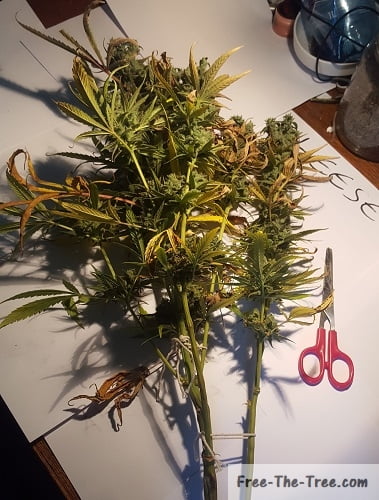
Freshly Harvested Tree
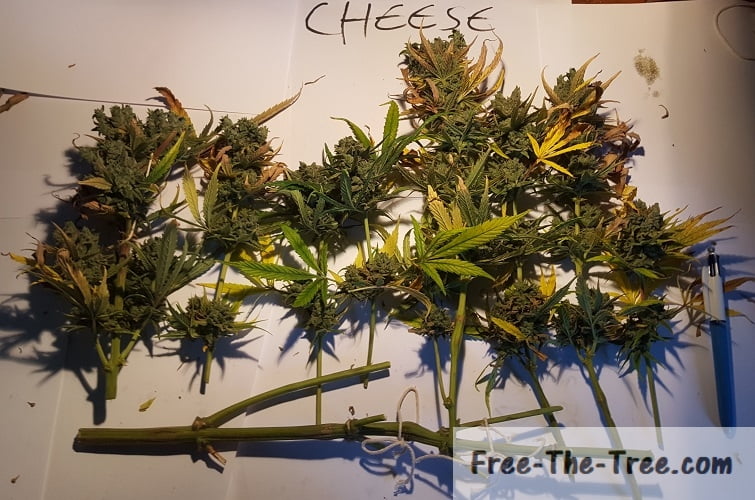
Branches cut from the tree and ready to be pruned
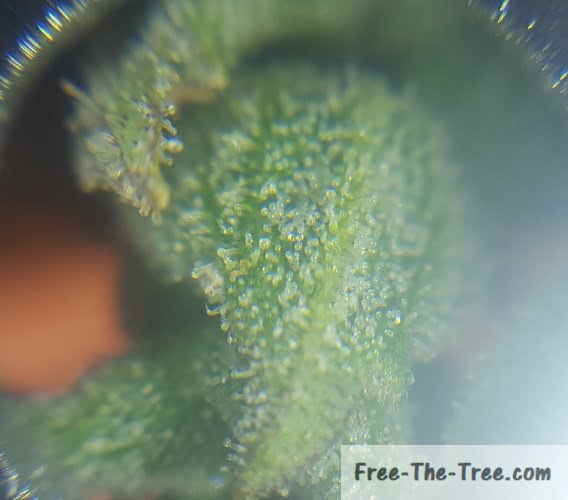
Whole bunch of nice, milky trichomes
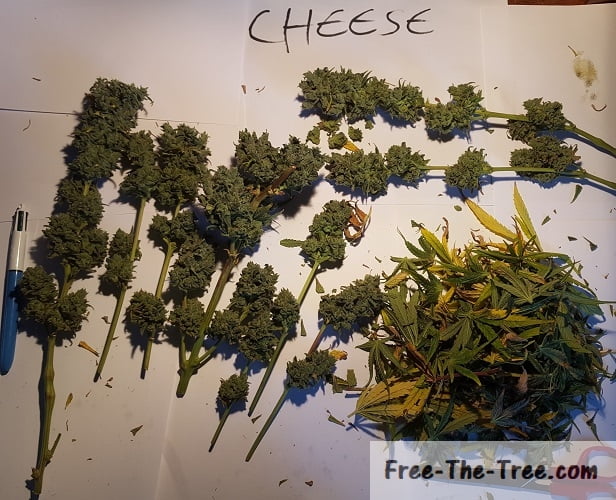
Buds pruned and cleaned, ready to dry
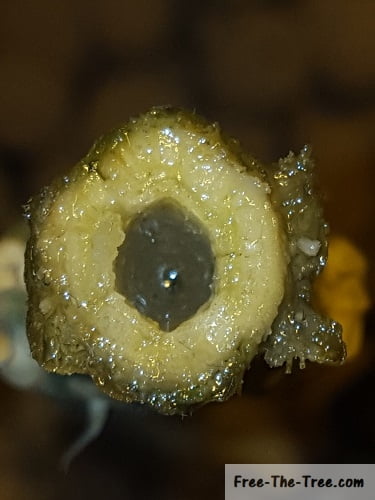
The sap kept flowering for a couple days, showing that the roots were still active!
It’s really too bad she had stretched as much as she did, I really think that she could have produced much more buds if she wasn’t as close as she was to the bulb.
We def should have scrogged her like the others in order to reduce her main height. Good to know for next round ^^
Harvesting the Blue Thai Plant
This little one was pretty small, since the cheese stretched it basically hid half the plant for getting a direct source of light so we weren’t expecting much.
Her smell is crazy though, full of spices.
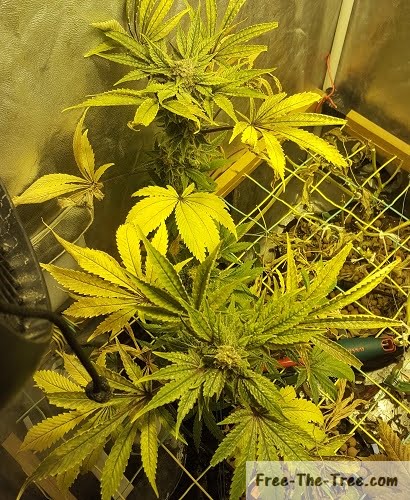
Blue Thai plant freshly harvested
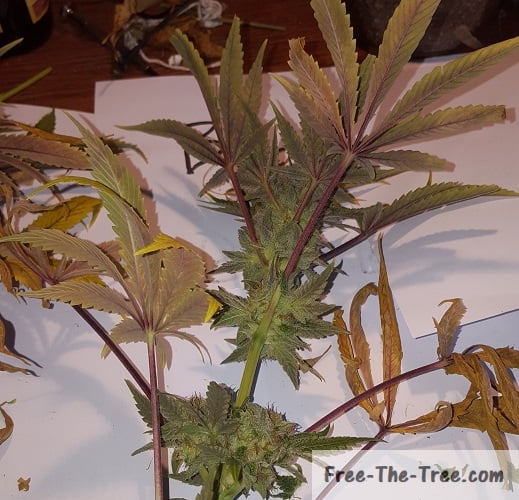
Branches cut from the tree and ready to be pruned

Small Blue Thai bud with purplish color
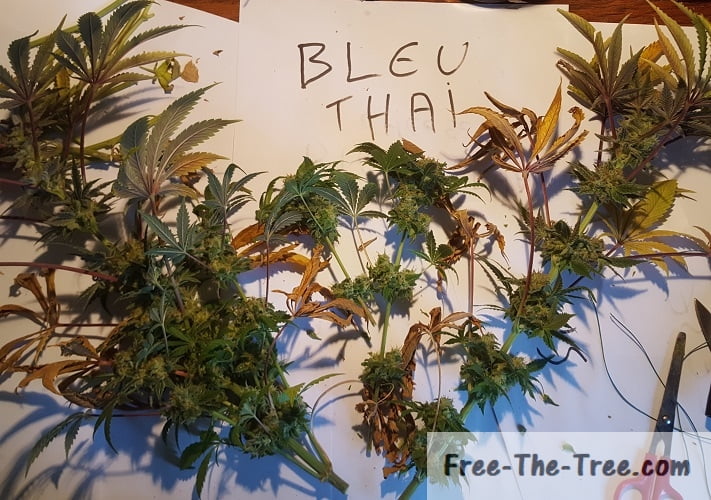
Each cola’s cut, ready to start pruning
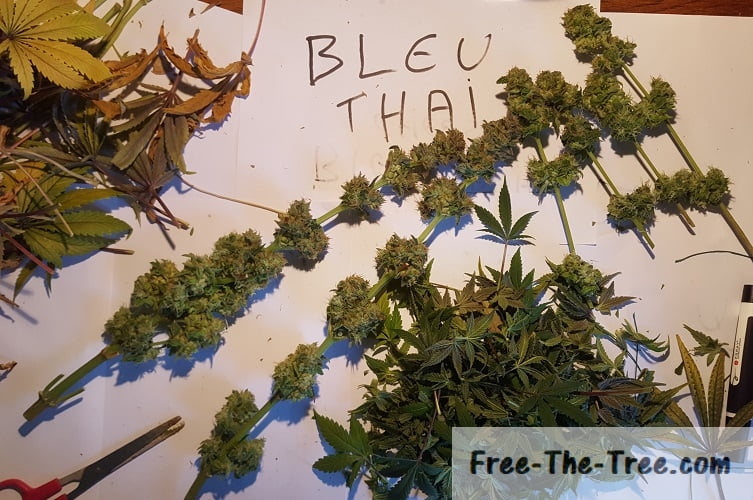
Pruned and ready to dry
As you can see the flowers aren’t that dense around the stems which is unfortunate, letting that cheese plant stretch so much really did damage to the yield of this little one.. (and to the blue kush up next)
Harvesting the Blue Kush
The Blue Kush is a pretty beautiful plant, especially since we were able to get temp differences over 10°C between day and night hours, allowing the plant to get that purplish/blue color. Unfortunately, she also stretch hard due to the Cheese.. Competition for the light source doesn’t joke around ^^
As you’ll see in the images below, she really built up her stem size, producing only a few scares buds 🙁
She really suffered a lot more from the heat than the Cheese plant

The Blue Kush’s last instants in the tent – You can see the heat stress on the Apex
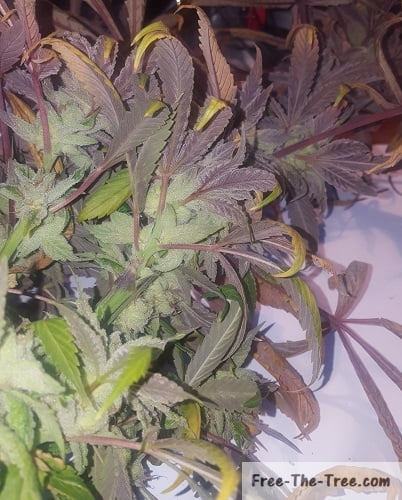
Freshly harvested Blue Kush Cola wearing her Beautiful Purple dress
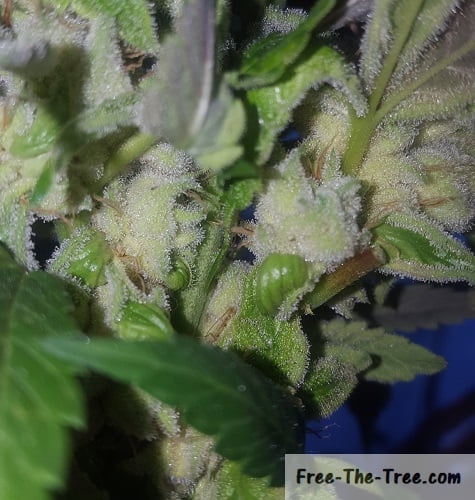
Focus on bud full of Trichomes

The 3 Blue Kush Cola’s harvested. More leaf and stem than bud

Pruned and ready to dry
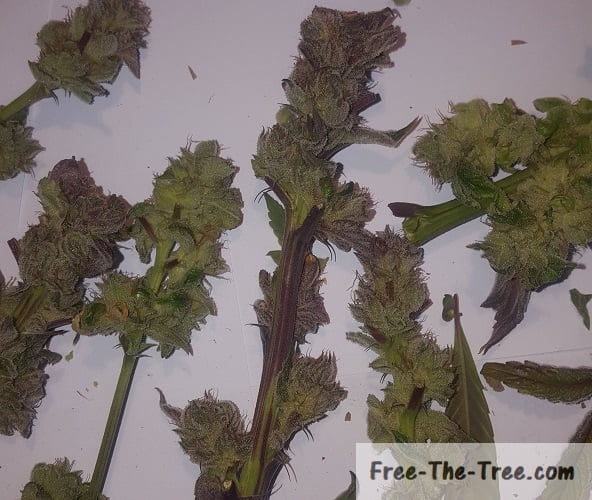
Close up on some of the purple flowers
Between the stretch for light and the heat stress generated from being so close to the light this “little” one really didn’t produce a lot of buds, although she really was beautiful.
I don’t feel as bas as the Blue Thai since we’ve germinated 3 seeds of this one for the next round, we’ll get another crack at her 🙂
Remaining Stems & Roots
Before we get to drying and curing of the buds, check out the nice stems and root systems these babies had developed
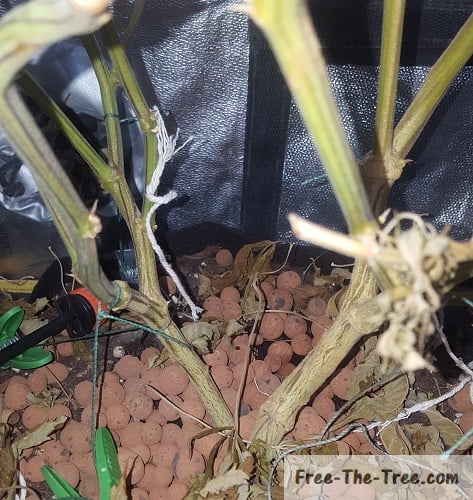
V Stem used as base for SCROG
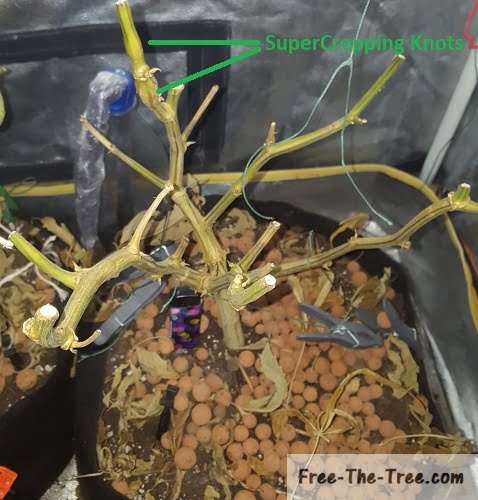
2nd Scrogged Big Budha Cheese Plant
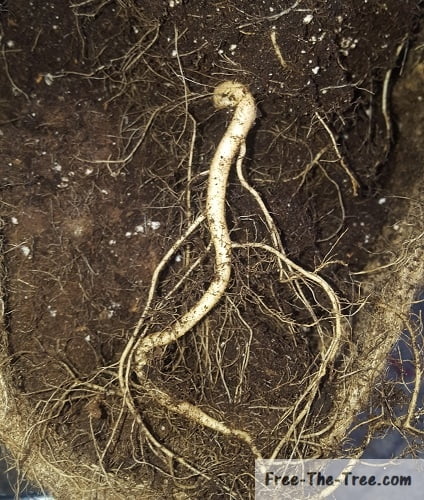
Main tap root (yeah, same one that broke the seed shell ^^)
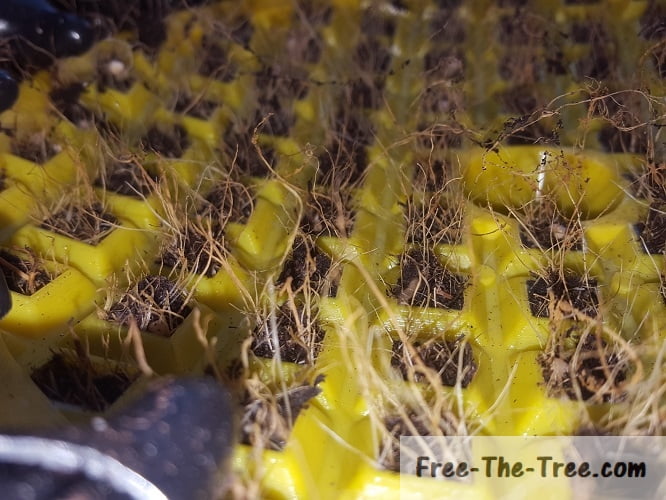
Naturally pruned roots at the base of the Air pot
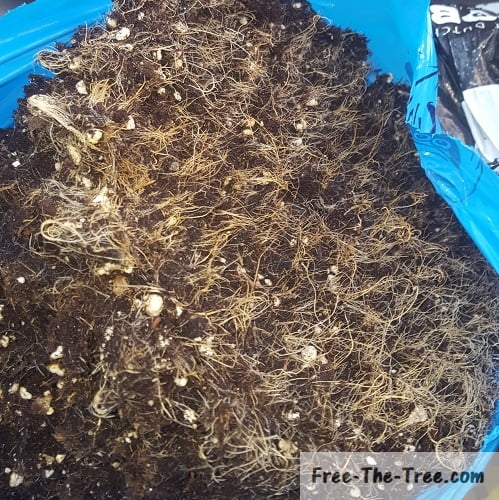
Root system developed when using an air pot
Aren’t the root systems awesome? Between the thick tap root and the thousands of mini roots, no wonder they kept producing sap even days after harvest.
The Blue Kush had even grown so much into the fabric bag that it tore when we tried removing the soil, crazy ^^
Seeing this I definitely see why it’s an issue to be using plastic pots, and definitely won’t ever be using them again.
Drying and Curing the buds
Now that all our plants are harvested and pruned we’ve done about half the work, the most crucial steps of the whole process still lie ahead.. Drying and (especially) Curing your buds.
We did a whole article over here if you want all the details, here we’ll mostly just show you the pics of this round’s drying and curing, since we had a bit more than we could handle we had to get inventive ^^

Cheese and Big Buddha Cheese buds drying in cupboard
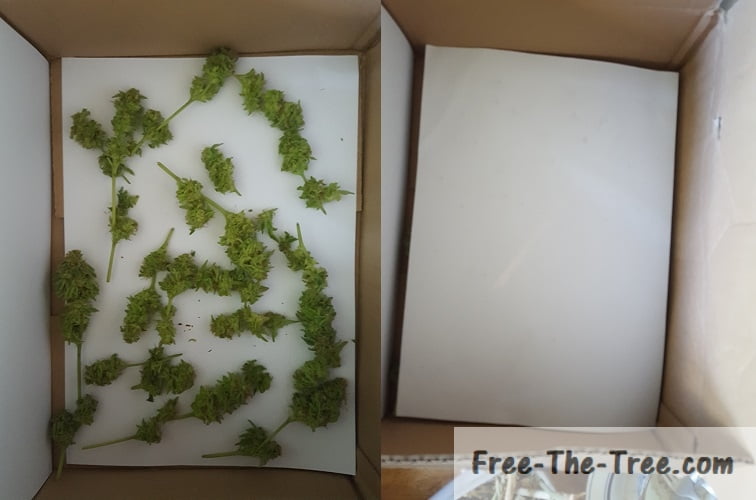
Buds drying between sheets of paper in a cardboard box
If you can, definitely avoid the cardboard box solution, the buds at the bottom may finish flattened due to the weight of the buds on top. If you must go for this, rotate regularly the layers of buds.
The important here is to keep your buds in a dark and dry space. Personally I do this until your hear a little crack when bending the stem, at which point they go into some jars to start the curing process 🙂
Key points during the drying process:
- Keep your buds in a dark area; Light will attack the trichomes
- Keep the buds in a dry space.
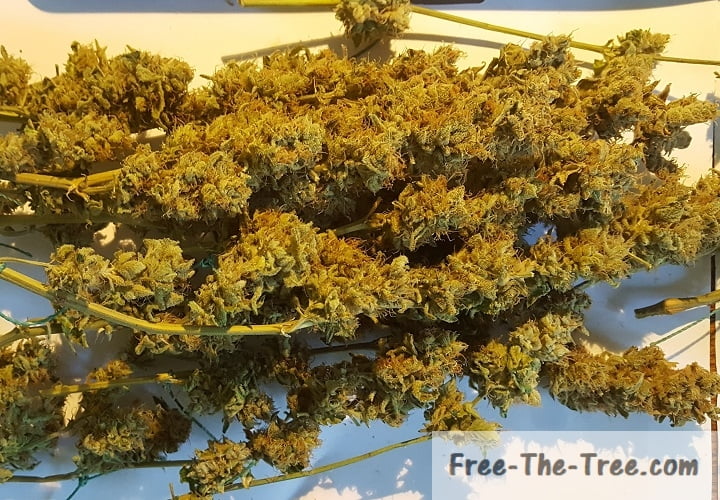
Buds done drying – Ready to weight and cure
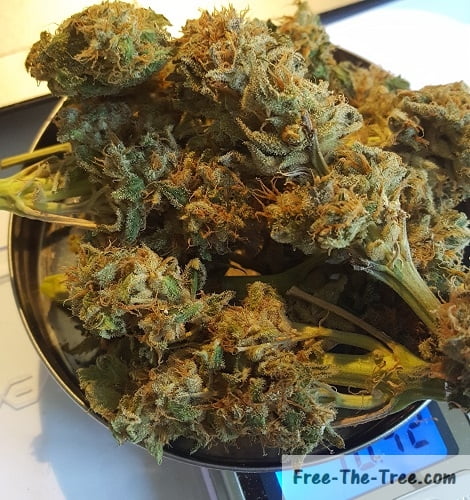
Blue Thai buds on the scale
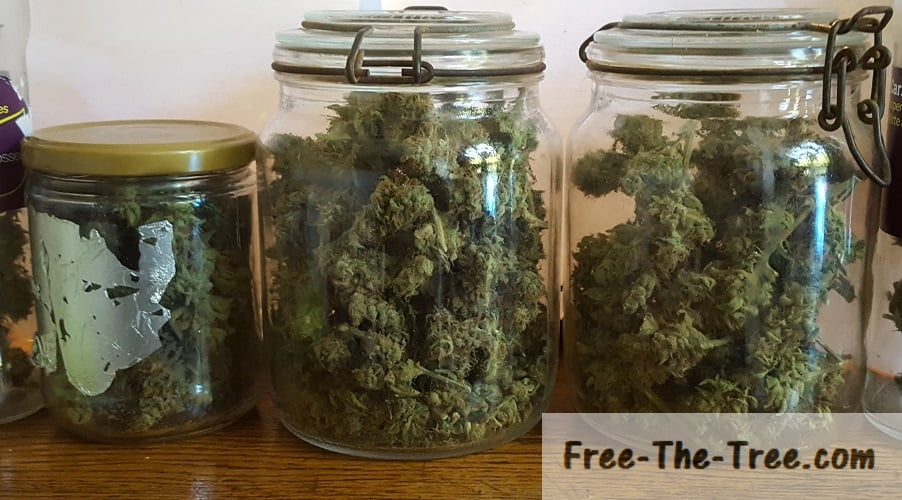
3 of the Big Buddha Cheese jars
Now that your buds are in the jars the process is almost over!
The flowers should still be pretty humid, so for the next 2 weeks you’ll want to open them at least a half hour a day.
Once they start to be crispy, you can add a humidifying packet (~50% humidity) and open them every other day or so.
Key points during the curing process:
- While the buds are still humid, open the jars regularly.
- Store in a dark area. Just as it’s true during the drying process, light will attack trichomes.
- Regularly rotate the buds inside the jar. Since the ones on top will dry faster, you’ll want to even it out.
- Curing can go from 2 weeks to 2 years, just like wine taste and smell will improve with time.
If you go for a long term cure, remember to add humidifying packets. if you don’t the buds will be so dry that they break like dust.
Before we wrap up this final grow report of the series we wanted to go over the main teachings that came to our mind while writing this piece, so here we go
Key Teachings of this Grow
- You must nurture your soil
We all agree that trashing your soil every other grow isn’t a long term solution. That said, plants suck out all nutrients from the soil and the nutrients that are given generally only contain NPK, whereas the plant actually needs over 20 macro and micro nutrients which got us thinking.. how do we get this working long term?
After a bunch of research we found alfalfa and nettle manure which feeds the soil with all these nutrients. That discovered, we decided to plant a bunch out side and start making our own to regenerate our soil, we’ll keep you posted! 🙂 - Thrips are a bitch
Yeah, these suckers followed us since the end of last grow, throughout this one, and we still have signs in the next one.
If you have signs of these suckers, nuc’em!!! - Keeping a flat canopy is key
If you’ve been following this grow you’ve seen that since the stretch our canopy is far from even, and as you saw, especially with the Blue Kush and Blue Thai, this had a very significant impact on the final yield of each plant. - Don’t wait too long to harvest!!
By waiting too long the trichomes start to deteriorate too much and the THC&CBD levels actually go way down. I think we weren’t too far from that with the Big Buddha Cheese - Super Cropping seems to work very well
Alright folks that’s it for this one!
Hope you enjoyed the last post of this series, see you soon with the first months worth of the our 3 Blue Kush’s and 1 Critical plants that are currently nearing the stretch 🙂
Until next time,
be safe and grow easy
Hey there and welcome to this weeks grow report!
The end is near 🙂 This week was pretty cool, we harvested our first Big Buddha Cheese bud, the Blue Kush started to put her purple dress on, and globally the buds are getting preeeetty close to being ready for harvest.
Let’s get into it
Harvesting the first BBC Cola
Since the Big Buddha plants are pretty far back it’s been hard for us to monitor the trichome situation. We’ve cut off little sections of the flowers to look at is closer, but to be honest it’s hard to get a full picture and we can’t do it too often.
As much as we’ve seen the trichomes were milky all around with some amber ones coming in, in order to get our mind set we cut down the bud closest to the Blue Kush. Best case scenario, it’s perfect timing and we go for a full harvest, worst case it’s a little early but our Blue Kush has more room to breath and the Thrips can’t move around as easy. Basically, win win ^^
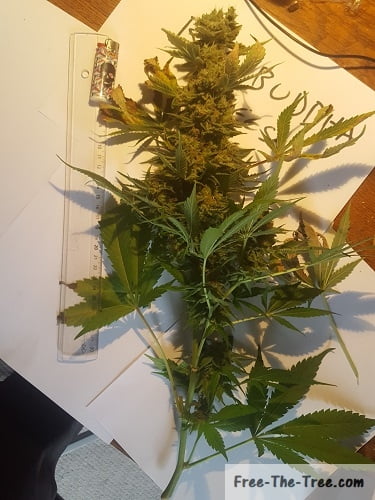
Freshly Harvested Ganja Flower
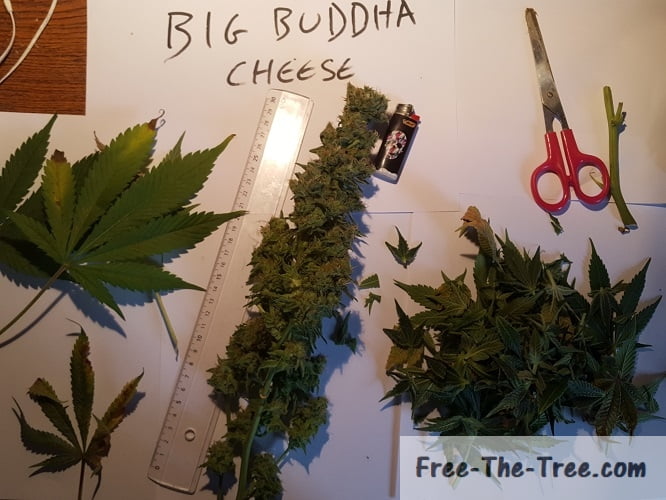
Leaves are pruned off, Bud is ready to go dry

Trichomes on the Buds – Mostly Milky but some are still clear, others going amber.
Nice bud isn’t it? 🙂 But as you can see in the trichomes it’s still a little early to go ahead with a full harvest, a lot of the trichomes are still clear. We’ll go ahead and wait a couple more days before harvesting all the other BBC Cola’s
Thrips all over the harvested bud
Since we have a known problem with Thrips during this grow we decided to go ahead and shake the bud to see if any thrips would fall, and fall they did..
We probably killed 4/5 adults and a bunch of larvae’s crawling around. I really hope they won’t damage the buds while drying.
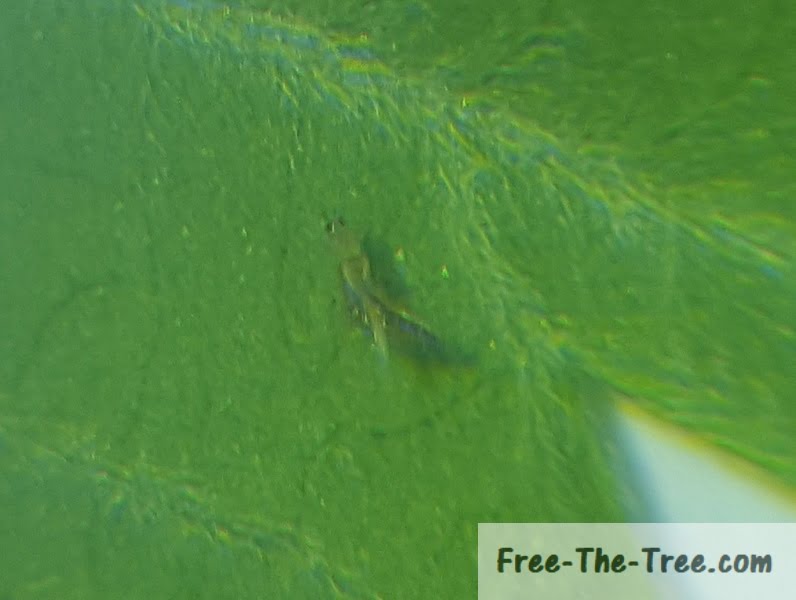
Adult Thrips spreading its wings
Blue Kush’s Foliage turning Purple
During this week the Blue Kush totally transformed, I really didn’t think it would go this fast. At the beginning of the week the first leaves started to show purplish colors and just a couple days later there she was with a (near) total purple foliage, a beauty.
Here’s some pictures of the evolution, as always click on them to get the full view
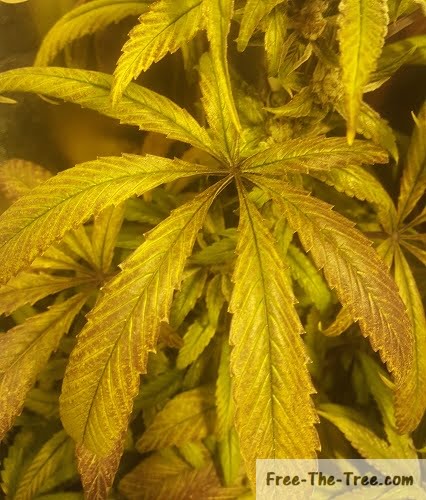
First Purple colors starting to show

Purple color growing on the foliage
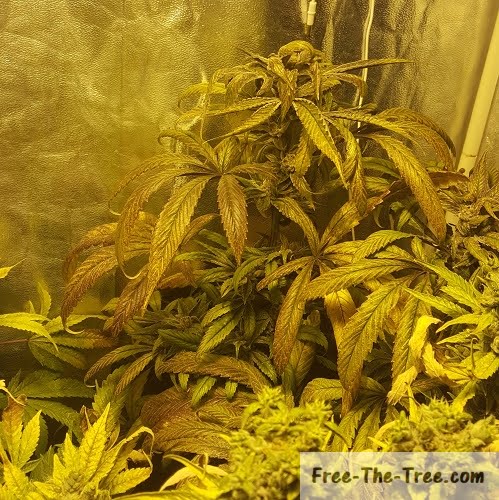
Foliage totally turned purple
Getting the Buds Standing Up
A couple of our buds were falling over due to the weight of their own flowers. The main problem with this is that the leaves aren’t getting the maximum amount of light and she’s leaning over onto her neighbor. We had to get a little crafty in order to get her back and standing by tying a (very) lose knot on the leaf stem.
It’s important not to tie it tight, we need the plant to be able to pass the sugars back down for use ^^
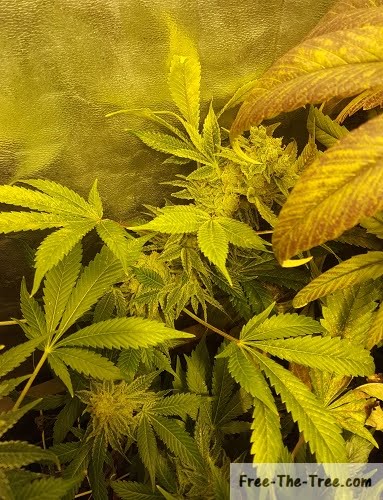
Bud falling over due to the weight of the flower

Loose knot made around leaf stem to keep the bud standing

Bud standing up and not bothering her neighbor anymore
Buds Ripening Up
Be aware, the picture need to be seen with weed available around you haha.
On a more serious note, by the end of the week these buds have gotten unbelievably nice, the smell is overwhelming, we’re constantly wearing a “marijuana perfume” on our clothes, it’s crazy. Can’t wait to taste these babies 😀
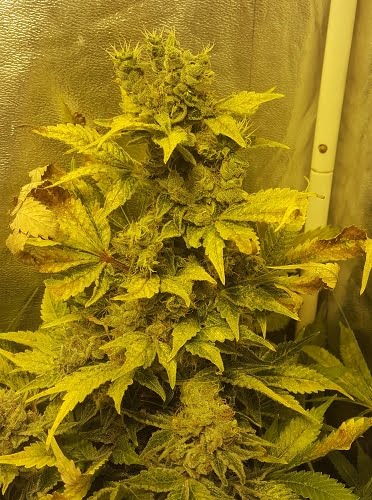
Main BBC Cola – Real fat but the Calcium deficiency makes a weird looking Apex
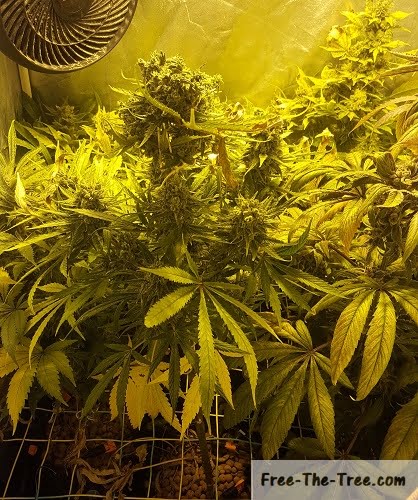
3 Foot Cheese plant with fat buds

In the middle of the colas jungle :p
Aren’t they beauties? I really which I could pass on the smell to you, it’s mind-blowing haha. We’ve had to take strong counter-measures since our neighbors were getting the smell all the way to their houses. I think it’s the cheese’s stanky smell that is to taking and pungent.
Next round of seedling chillin
The 3 Blue Kush and Critical seeds that we germinated last week all survived and are now nice little seedlings 🙂 We’ve got them under a small ~80W light since they don’t need much at this stage, most of the activity is going on under-ground with all that root growth.

Main BBC Cola – Real fat but the Calcium deficiency makes a weird looking Apex

3 Foot Cheese plant with fat buds
Although we still have a little time, I think we germinated these little ones a little too early, we’re close to harvest but, in the best of worlds, these little ones might need to get in there sooner than possible.. We’ll see how it goes.
Alright folks that’s it for this one! Next week we’ll most likely be harvesting most of the buds 🙂
Until then, be safe and grow easy!
Miss a couple episodes? Here’s all our other Grow Reports
Read up on our Indoor Growing Tips!
Hi there and welcome to this weeks grow report!
This week was pretty chill, trichomes and flowers keep developing, the Blue Kush started showing her beautiful blue/purple colors and the smell is oh so beautiful, I wish there was a way you could smell them.
We’re still hunting Thrips, adults and larvae’s, on a daily basis. At the end of this round we’re cleaning everything with Clorox and changing all our soil. Those suckers are so persistent once the plants get big it’s horrible.
Trichomes growing like crazy
For the past couple weeks trichomes have been growing but during this week this ramped up strongly.
As you can see in the images the buds are covered with them, especially on the Blue Kush flower.
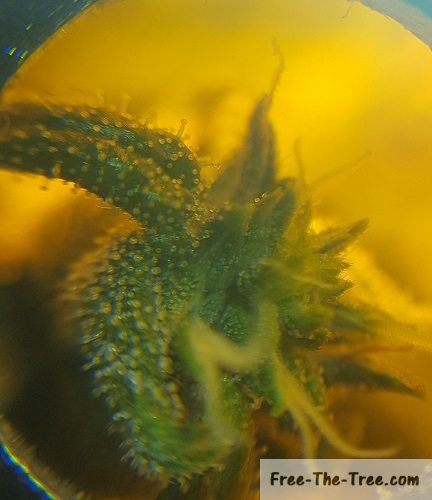
Cheese Strain Clear & Milky Trichomes
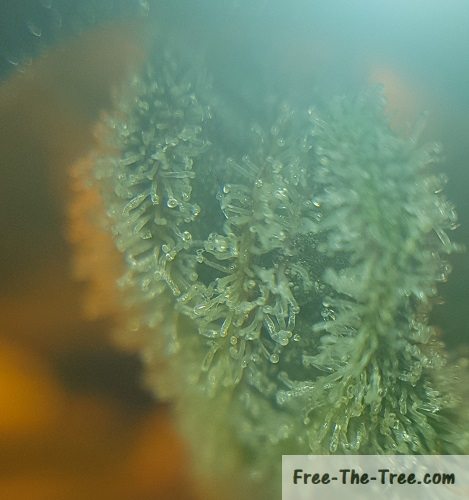
Kush covered with trichomes

Clear trichomes all over the pistils
Blue Kush Leaves turning Blue/Purple
The Blue Kush, from Dinafem, can turn a blue/purplish color during the flowering stage if there’s 10°C difference between day and night temperatures, and this time we have them! 🙂
As you can see in the image on the right the fan leaves have started to turn purple little by little. I really can’t wait for her to fully develop her purple dress.
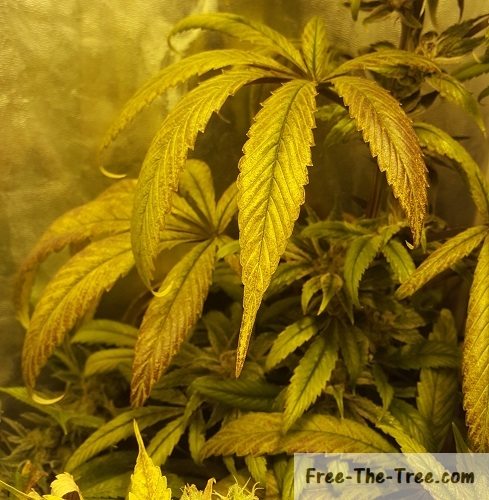
Leaves Turning Purple
All Strain Buds Fattening Strongly
We started saying this last week, but just like the trichomes the growth of the buds has really rapped up strongly.
Whether it’s the Cheese buds thickening strongly or the Big Buddha Cheese buds, the buds have probably taken about 10% in size since last week!
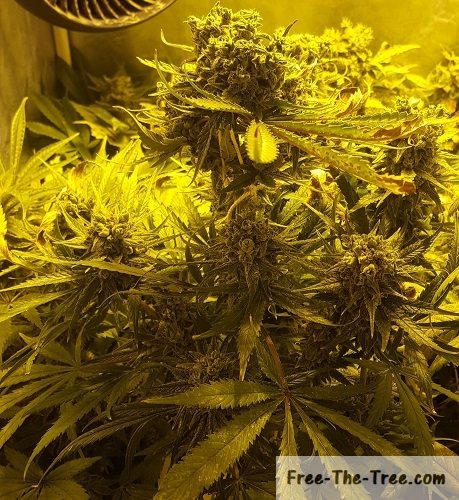
Cheese buds fattening up
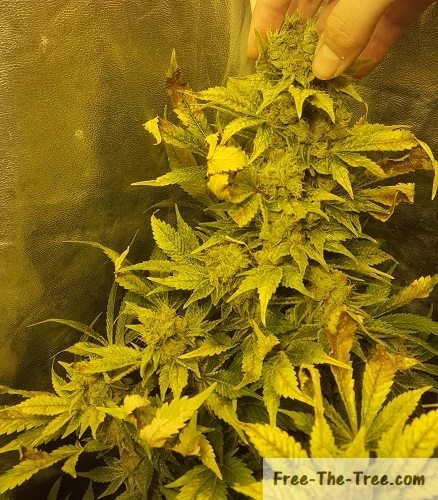
Largest Big Buddha Cheese bud over 30cm long
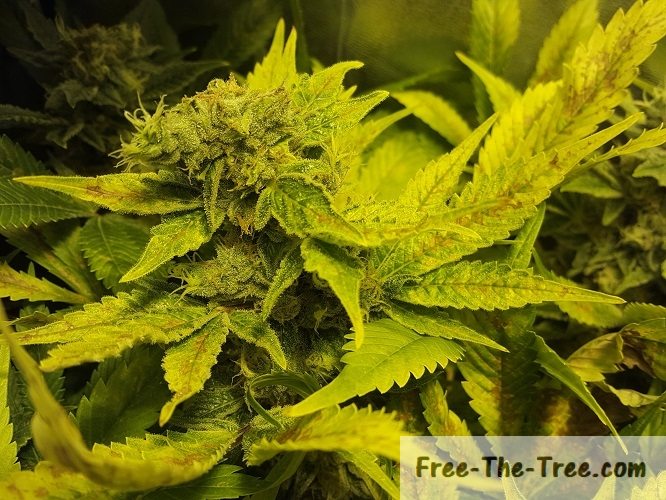
BBC pistils growing making the Bud bigger and bigger
On the other had, the Blue Thai’s buds are really small. Looking at the trichomes, since they’re all still fully clear, the plant seems far from ready to be harvested to there’s hope for them to increase strongly… We’re not really counting on it but fingers crossed.
That said, as you can see in the image on the right hand side, they’re covered in trichomes. We’re really hoping these buds are going to get much bigger than they are currently.
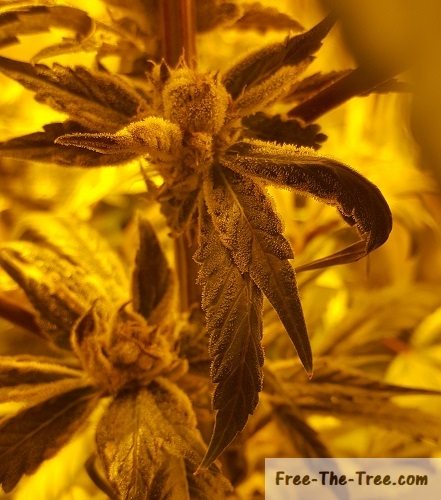
First set of leaves growing on Seedlings
As we said in last weeks post we planted 4 seeds for our next round and honestly they’ve been growing pretty nicely. We set them in a little corner under a light, with 2 pieces of paper on each side acting as reflectors.
As you can see the plants seem to be liking it pretty well, the first set of leaves have grown and the second stage is coming in 🙂
Thanks to this we’ll have saved about 3 weeks of early vegetative stage.

Next round of Seedling Growing
Alright folks that’s it for this week.
Until next time, Be safe and grow easy!
Miss a couple episodes? Here’s all our other Grow Reports
Read up on our Indoor Growing Tips!
Hi there and welcome to the 8th week of the flowering stage!
Sorry for being late posting the grow reports, we’ve been working hard on getting the Strain&Seed comparison tool up and running 🙂 We’re still working on the styling and getting many more stores, strains and characteristics but soon enough it’ll be awesome ^^
I’m getting off topic here, this past week a lot has been going on in the grow room. The smell is just crazy (my neighbors started to complain…), the buds are getting thicker and thicker, just looking beautiful. We’ll also get into the topping of Cheese plant and harvest a BBC bud.
On the negative aspects, we’re still manually hunting thrips manually, which is oh so fun… and the Calcium deficiency is still spreading a little, which was expected.
This week we also decided to germinated 4 seeds for the next batch. Their seedling stage will overlap with the flowering stage of our other buds allowing us to save about 3 weeks time.
Next round we’ll be growing 3 Blue Kush’s and 1 Critical + plant
Here’s some links if you want to skip straight to a section:
- Calcium deficiency spreading
- Topping the Cheese Apex Buds
- Harvesting first BBC Buds
- Buds Fattening up
- Starting Seeds Germination
Calcium Deficiency still Spreading
We’ve been treating the plant for a little under 10 weeks now and as you can see on the image on the right, the deficiency is still spreading.
Since Calcium is an immobile nutrient it depends on the plants transpiration is order to move around. Within the next couple days the spreading should stop.
This deficiency definitely gave the plant a hard hit leaf mass wise..
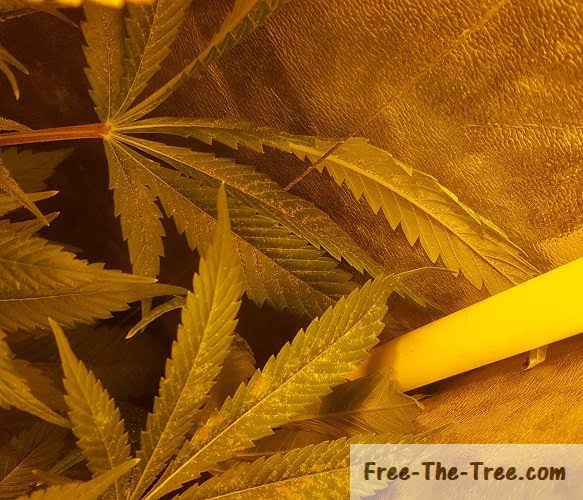
Topping the Cheese’s Apex Bud
If you’ve been following this grow then you’re aware that our cheese plant’s stretch was pretty massive and we’ve had to deal with a very un-even canopy ever since.
Although we had super-cropped the Apex, the plant was still was still waaaay to tall and shading the two on each side, and now that the trichomes are starting to be nice we decided to go ahead and top the Apex.
It could of definitely grown more, and denser, but now all the buds underneath have direct access to light AND she isn’t shading as much the Blue Kush and the Blue Thai
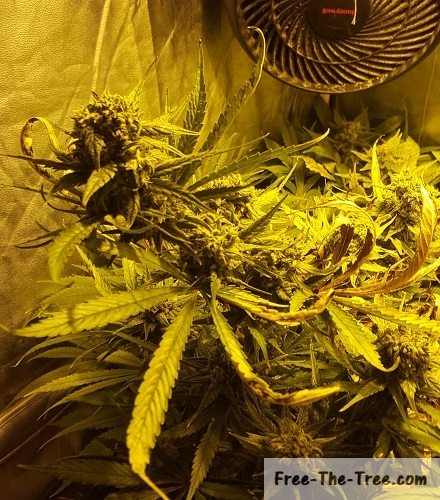
Cheese before being Topped
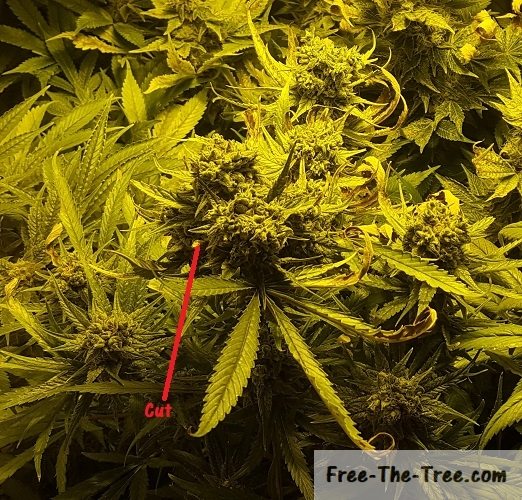
Cheese after being Topped
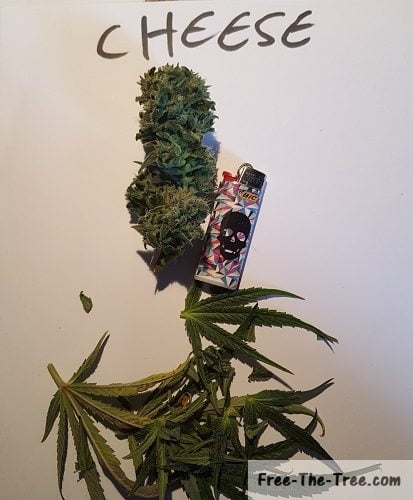
Nugget harvest and Pruned, ready to be dried & cured
I won’t lie, it did kind of hurt to chop down this bud, especially since the Apex generally’s the best bud on the plant ^^
It’ll give us an early taste of this cheese, although it isn’t ready.. Here’s what her trichomes looked like

Mostly Milky Trichomes of the Cheese Strain

Trichomes under the Scope
Harvesting the First Big Buddha Cheese Bud
Our 2 big buddha cheese plants are really massive and it’s difficult for us to really be able to see the trichomes. Normally within 55-60 days of flowering she’s ready and were nearing the 60th day now.
With all the deficiencies they’ve had we’re pretty sure that they’re no where near ready but we still decided to go ahead and harvest a bud.
We chose one that’s near the Blue Thaï, compressing her and not giving much room to breath. This move will at least have the benefit of giving a little more room for her.
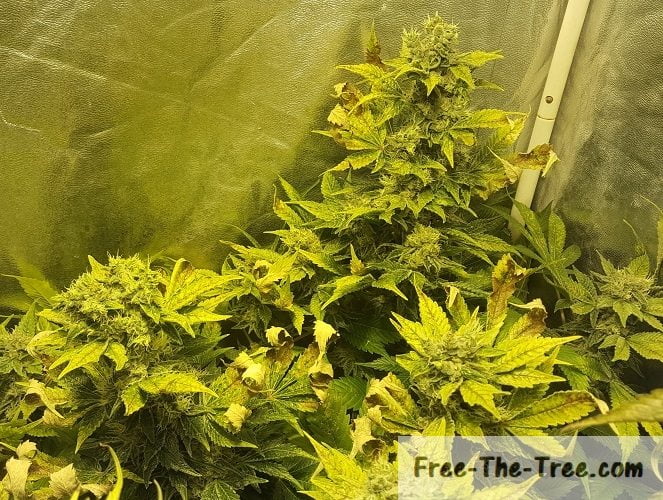
Big Buddha Cheese 8th week of flowering stage
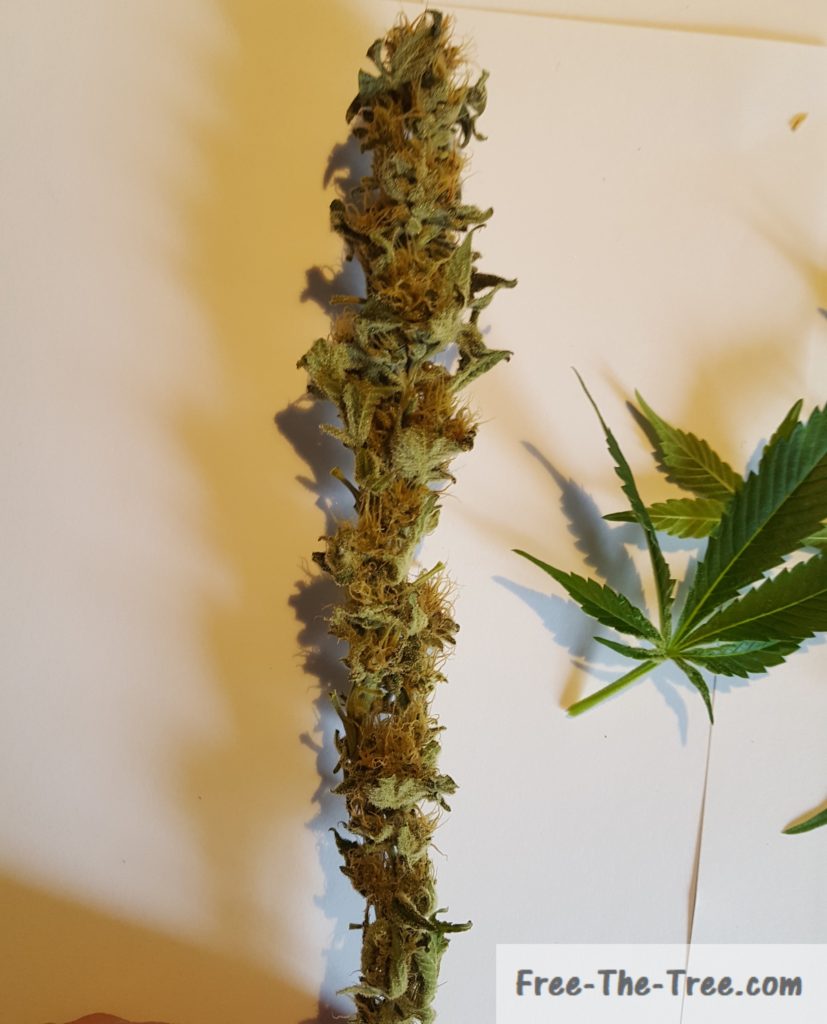
Small BBC Flower harvested
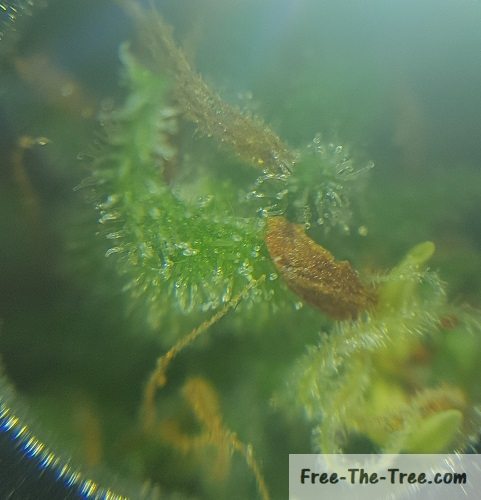
Trichomes all over the Pistils
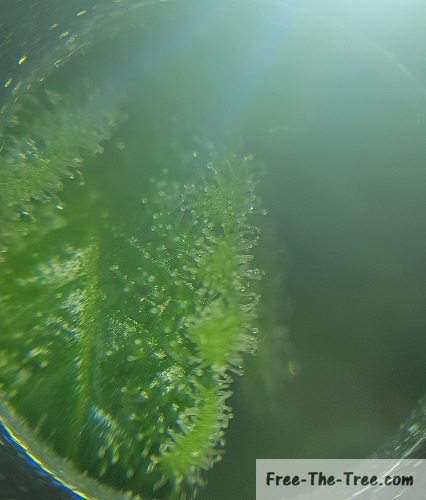
Trichomes on the leaves
Buds Fattening Up
During the past couple weeks the buds have been getting fatter and fatter, the pistils keep growing, the smell is getting extremely strong and really they’re looking awesome 🙂
Looking at the small bud further up as well as the others, I think that we’re about 2 weeks out in order to harvest the Cheese and the Big Buddha Cheese and maybe a week more for the Blue Kush and Thai. With this in mind we’ve decided to start flushing the plants little by little.
For the next watering or two we’ll reduce the amount of nutrients (except for the Calcium), then just give them pure water (still keeping the molasses though)
Here’s a couple picture of them at the end of the week
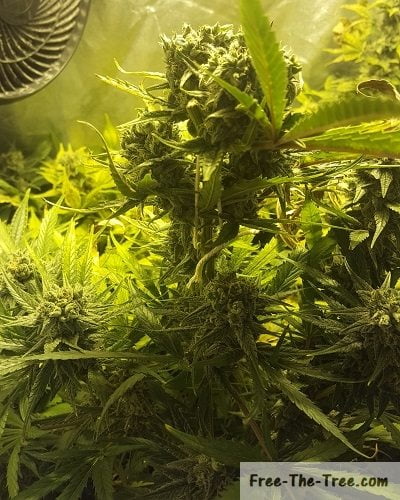
Cheese Buds fattening after topping
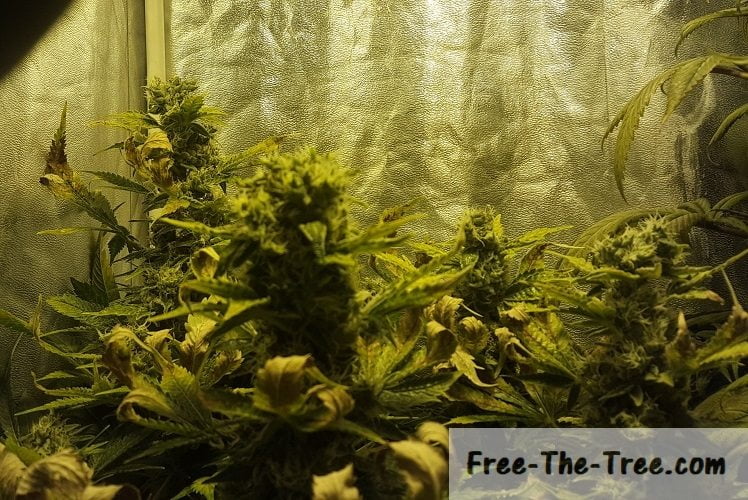
Horizontal view of Big Buddha Cheese multiple Cola’s

Close up on BBC flower developing
Germinating the Next Seeds
Since there’s about 2/3 weeks left in the flowering stage of the current grow we decided to go ahead and start the germination of next round in order to save some time.
Since plants don’t need that much light during the seedling stage, we’ll keep them under a side light for the first couple weeks, until we harvest this round.
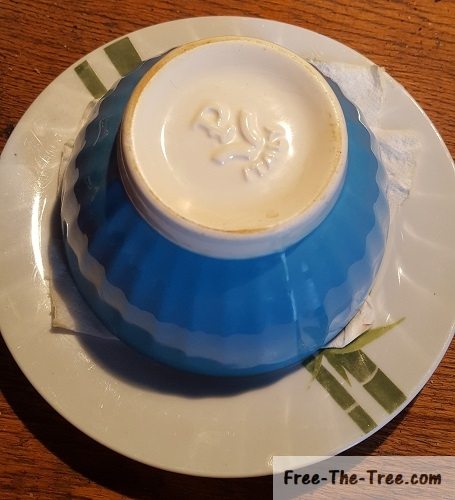
Kush and Critical Seeds Germinating

Tap root breaking the seed shell
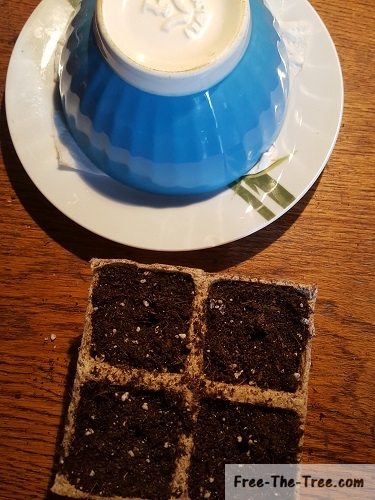
4 Germinated Seeds planted into medium
We decided to germinate 3 Blue Kush’s and 1 Critical+.
We’re going to do a quick round with those, do a LST and try to get some little fat bonsai’s for that round 🙂
Alright folks that’s it for this week.
Until next time, Be safe and grow easy!
Miss a couple episodes? Here’s all our other Grow Reports
Read up on our Indoor Growing Tips!
Hello Community! 🙂
For my first post here I decided to share why, in my opinion, you should grow your own weed at home. I’m really excited of joining u, hope you’ll find this first piece useful
The (Surprising) Reasons Why You Should Grow Your Own Cannabis
In the advent of worldwide legalization, cannabis is becoming more and more available to the everyday consumer. Dispensaries are springing up like mushrooms in legalized states in the US, making a billion dollar industry.
Despite this boom, more and more people are growing at home. The benefits of growing your own are obvious: economical, social, knowing (and choosing) which strains you’re going to smoke, quality control and just because it’s fun!
If you look just at the economical side, with a modest grow room, which averages between 300 and 500 bucks, can get you a grow-op setup that will pay for itself in as quickly as one harvest.
Other benefits, which you may discover as you become a habitual grower, are not so obvious. Here are a few:
Strains, strains, strains
Even with the recent trends in decriminalization/legalization, chances are you live in a city where you have to depend on your local dealer for your weed. If you ask him/her what strain you’re buying, most likely you’ll get an answer that basically means: smoke what I give you and don’t be fussy.
Ask about the THC/CBD/CBN ratio of the baggy you’re buying, and you’ll probably get a blank stare.
However, as a habitual smoker, I know that certain strains are good for certain needs, and the wrong strain can have the opposite effect.
You’ve heard that cannabis is great for insomnia, but a high THC sativa could raise your brain activity to hyperdrive, therefore making you count sheep until dawn.
You want to use cannabis to push your focus and production on a creative project; however the heavy indica your dealer was able to sell you has you unable to get off the couch eating a bag of potato chips while watching nature documentaries.
If you’re lucky enough to live in a city that has legal dispensaries with qualified staff to advise you on the exact type of strain you need, that’s great. But most of us don’t, and so growing your own will allow the choice and the autonomy of getting the right kind of effect or medicine.
You will drink less
I have noticed my need for alcohol has greatly decreased. Whether it’s to unwind at the end of the day, or at social occasions, if you are pleasantly buzzed with a weed high, you’ll find you don’t have to drink at all.
Over the years I’ve helped many friends cut back on alcohol consumption by substituting with cannabis. The “Dry Month of January” doesn’t sound so dreary if you allow yourself to take the edge off with a joint now and then.
And if supply and cost isn’t an issue, who wouldn’t choose an evening socializing with an uplifting weed high and a nonalcoholic cocktail, to a forgetful and clumsy boozy night followed by a hangover the next day?
Bottom line is, if you have a lot of weed, you’ll drink less. Even if you drink a couple of beers, you won’t feel you need more.
You will be richer:
If you are living in most of the developed world, cannabis runs at around an average of 10-15 USD per gram.
The cost benefits are therefore obvious even accounting for personal use alone. But what about the your surplus harvest? You can’t play the local weed Santa for long before you realize the “moochers” -or the people outside of your close group of friends- who don’t merit your continuous generosity. So, what to do with the rest?
Even with my humble 4 sq meters grow space, I cultivated my growing skills to produce much more than my close friends and I needed. You’ll inevitably come to a time when friends of friends of friends start to hit you up.
At 10-15 bucks a gram, and a surplus of a only a couple of ounces, you’re on your way to a little savings pot for that annual vacation or that little luxury gadget you always wanted.
You will be healthier:
I once had the chance to talk to a big time dealer. He didn’t move a kilo at a time, he moved tens of kilos. I asked him if he indulges in his product himself, and his answer was “I wouldn’t touch the stuff”.
The reason, he said, was commercially grown cannabis is almost always sprayed. By this he meant not only are the plants sprayed with pesticides, but he knows that lower-quality harvests are sprayed with Fentanyl (this has been debunked in the media as an urban legend, but there I was, chatting with a drug lord who admitted to the practice).
Fentanyl and carfentanyl are worrisome enough, but what about those pesticides? Even with a seeming harmless and organic-sounding pesticide like neem oil, your health is at risk. There have been links to neem oil and a terrible condition called Cannabis Hyperemesis Syndrome, although doctors are just now beginning to understand it. Because so little is known, it’s very hard to diagnose.
Even if you don’t take into accounts these 2 examples, by growing your own weed you know exactly what you’re giving her and (not) spraying the buds with making the product natural, safer and of a much, much, much better quality.
You will be more popular
When I started growing, I had just moved to a new city in an entirely new country. In fact, that was the reason I started growing: I wasn’t in any social circles where I could casually ask for a connection to a dealer, nor did I feel comfortable to venture my luck in unknown streets unequipped with how things worked and with my bad grasp of the local language.
Once I started growing, I used my discretion to choose who I shared my crop with. It took only a little while after to make friends.
Sharing cannabis is an immediate show of trust, and is great for social occasions. I was invited to more parties, which was both a blessing and a curse. It took a while for me to distinguish the moochers from real friends.
Cannabis, I found, was something “moochers” were drawn to, and I realized that some of my new popularity was due to people taking advantage of my supply of generosity. I learned to be more discriminating about the people I chose to spend time with; going from a phone that never rang to choosing which rings I would answer was a strange, but I realized I was learning to distinguish the people I really got along with from the people who weren’t worth my time. It was social scene luxury.
Oh my god, I wish I had learned to grow cannabis when I was in high school ^^.
You will have a wonderful, rewarding hobby
Agriculture –humans growing stuff – has played a huge role in the development of human civilization.
The immense pride and pleasure we get taking care of our crops is probably embedded in our DNA.
Have you ever been to someone’s house for a meal and your hosts beam with pride over their homegrown tomatoes? That’s how you’ll feel about your homegrown harvest buds.
As you hone your skills in horticulture, you’ll learn the basics of plant biology, perhaps get a little handy with electrical wiring, and maybe even simple DIY construction (like this automated watering system).
It doesn’t stop at the buds; you’ll learn to make edibles with the rest of the plant and perhaps try your hand at cooking and baking. Cannabis cultivation has almost infinite learning opportunities, and you’ll constantly be finding new tricks and tips.
There is also a friendly online community where people are generous with advice and support. And the best thing about it is that first high buzz you’ll get from a new batch… Each harvest is a sweet reward of your hard work and diligence. It really is a hobby that keeps giving.
Of course these are just a few of the many, many reasons one can think of, hope it’ll help you start your own grow!
If you do, or you’re already growing, send us a message and share you experience here with everyone here 🙂
Check out the Communities Grow Reports
Have a problem? Have a look at our Indoor Growing Tips
Hey there and welcome (back) to Free the Tree!
This week was pretty exciting, most of the trichomes have started to show, we decided to go ahead a cut down one of our Colas (way too early to do so), we started back building the buds aaaaand we finally got an image of a live, grown thrips (find pleasures in small things right ^^)
Let’s get into it
Trichomes turning milky
We’ve been watching the trichomes closely for the past couple weeks and they’ve been starting to get nice and milky, especially the ones on the side leaves.
You can see on the image on the right hand side that the trichomes are mostly milky with a couple still clear.
Since we’re looking for more of a upper effect we really want to harvest while the THC levels are at their highest, meaning when they’re all milky and have just started turning milky. Seems like harvest is coming up soon 😀
Important note: Something we discovered by the end of the week, but in order to measure readiness looking at the leaf trichomes isn’t reliable. You must look at the flower trichomes or the ones that are are the very small leaves sticking out of the buds.
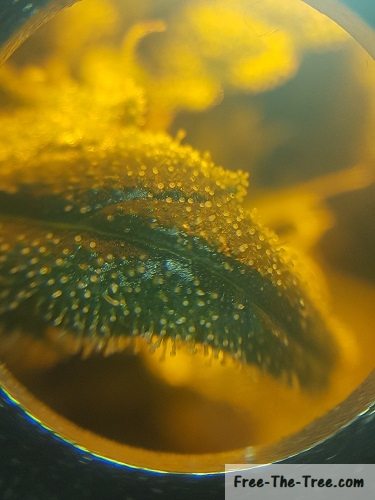
First Big Buddha Cheese Harvest
By the end of the week, after looking at many trichomes we decided to harvest a first cola.
We did this for two main reasons
- It seemed to be at that THC peak
- That cola was really pressuring the Blue Thai, which doesn’t have enough room and isn’t looking too great
Turns out, we really harvested her too early, as we said most of the trichomes are milky but there’s still many clear ones.
This bud definitely would have been much more massive if we had waited about 10 days before harvesting her… But at least we have a clear view of the development stage of the Big Buddha Cheese.

Harvested cola after pruning
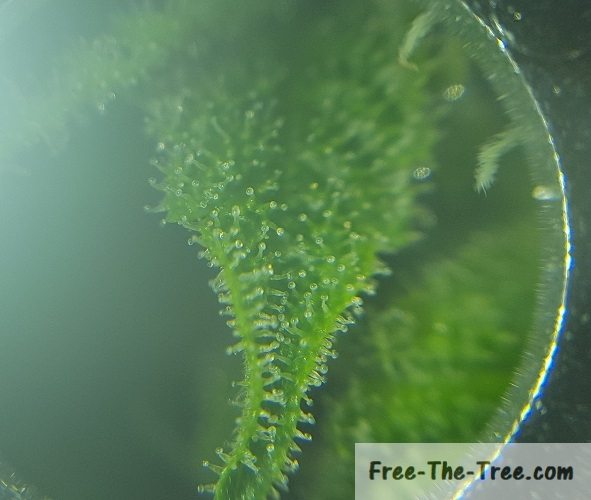
Clear and Milky Trichomes – Harvested too early
As you can see on the image on the right hand side some of the trichomes are still clear, we really cut this bud too early.. oh well it’ll be a soft taste of the rest of the BBC plant.
Back Building the buds
After cutting that the BBC bud we started looking into different ways to improve yield during the last weeks and crossed the “Back Building” technique. After reading into it seemed to be pretty effective, tested by many people within the community so we figured let’s try it out ^^
Basically the idea is to remove the top tip of the flower. The way marijuana flowers response is to stop growing in height and start getting thicker and fatter. Here’s a good video we crossed that shows how to do it pretty well.
Hopefully it’ll get the buds much fatter 🙂 keep you updated in the next reports
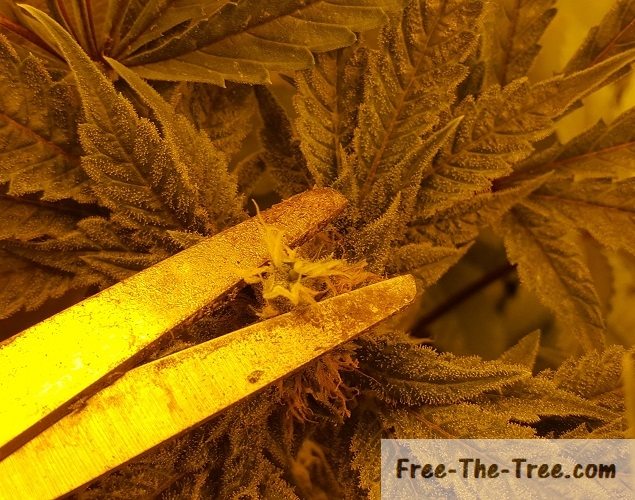
Back Building marijuana flower
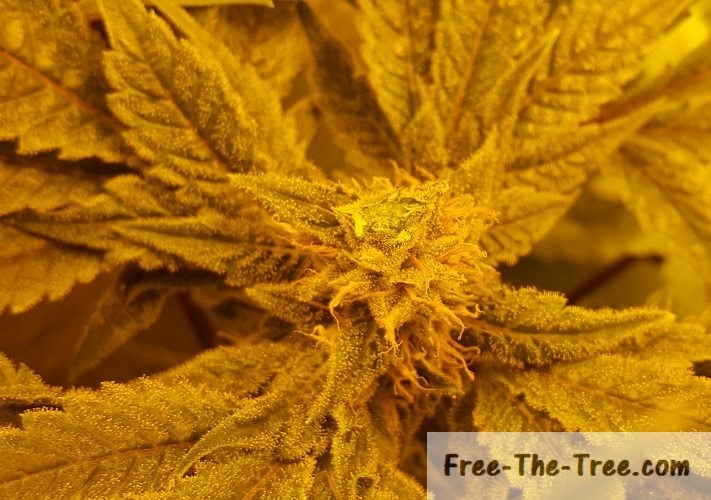
Top tip of the flower cut off
Thrips Thrips Thrips
While pruning the bud we harvested today we noticed one a couple thrips larvae and one adult thrips fall off.
Here’s two pictures of the adult thrips, if you want think you have a Thrips issue we’ve grouped everything together over here.
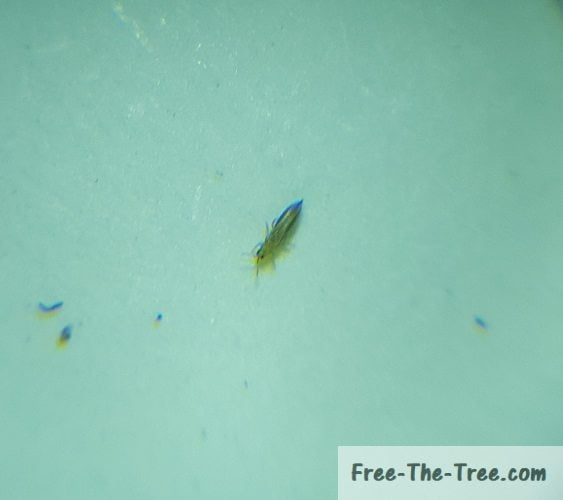
Front side of Thrips – Black streaks visible

Back side of adult Thrips – Looks whiter
Alright folks that’s it for this week.
Until next time, Be safe and grow easy!
Miss a couple episodes? Here’s all our other Grow Reports
Read up on our Indoor Growing Tips!
Hi there and welcome (back) to our weekly grow reports!
After just one small chill week the BBC started acting up again.. This time it’s calcium deficiency.. this really closes the matter for me, the soil is dead and we need to let it rest. Too add to this thrips are back and attacking the healthy plants & leaves :'(
The only positive point to this is that we got some pretty cool pics of them but really they’re killing me.. Let’s get into it
Trichome and Flower growth
We decided to go ahead and start with the good news, the awesome trichome and bud growth, even with all these deficiencies 🙂
FIY: click on the image to see the full view
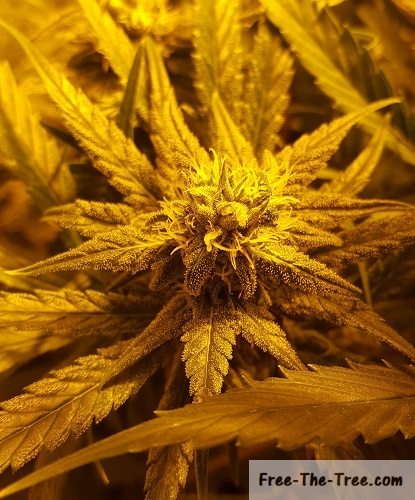
Bud and leaves full of trichomes
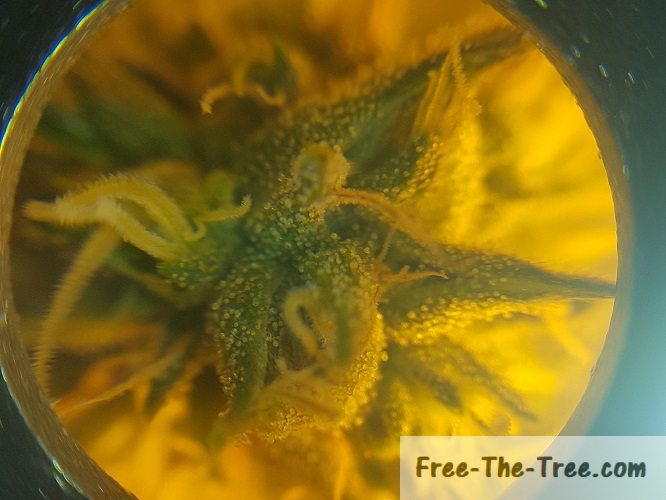
Close up on trichomes growing on pistils

Close up on trichomes growing on pistils
As you can see, 6 weeks into the flowering stage the plant has nicely developed flowers and the trichomes of nicely formed and some have started turning milky 🙂
This means that cannabinoid production has started, especially THC hehe; now we’re no where near close to harvest, there at least 3 weeks left for the Big Buddha Cheese plants and most likely a little more for the Cheese, Blue Thai and Blue Kush.
Within 2 weeks we’ll start flushing the Big Buddha Cheese so that in about 3/4 weeks we’ll be good to harvest her hehe
The return of the Thrips
Thrips, thrips, thriiiiiiiiiiiiiiiiiiiips, I’ve been infested with these suckers for now about 4 months, we thought we had dealt with them during the first month of this grow but they’ve returned for the past 2 weeks or so, and they’re busting my b***s to be fully honest.
We changed around the fans to that the back of the room is windy so that hopefully they stay on the plants at the entrance of the room. Along with this we spend a little time every day spotting and killing them manually (I must say we’ve gotten pretty damn good at it), but every day there’s still some larvae’s and adults..
We’re killing at least 10 larvae’s a day and a couple adults. We haven’t been able to get a picture of an adult thrips since they’re much, much quicker and at a certain point start to be able to fly also, and between a picture of killing it… well we’re killing those suckers ^^

Thrips larvae’s moving on leaf
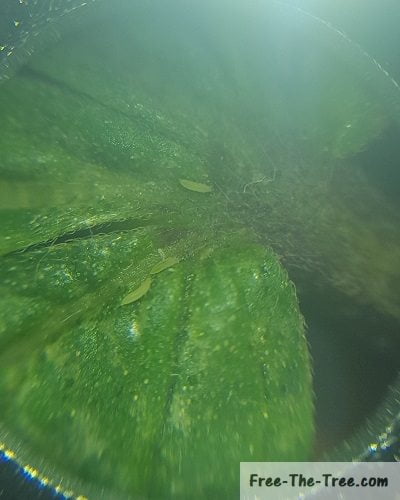
Larvae’s feeding on leaf
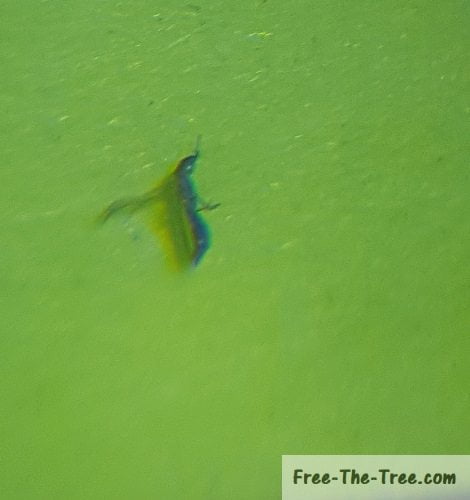
Dead adult thrip (really hard to get a good pic of a live one)
We’ve got a sticky trap in there but it doesn’t seem to be very effective, even on the adults. We can’t use neem oil or spinosad since we’ve got flowers.. Even hesitating on black soap..
We’ve been spraying the plants at night with some water to bother them as much as possible and pruning the most impacted leaves as the one above but it’s not enough to eradicate them..
Tip: Don’t re-use your soil after being infested with Thrips!!!
Calcium Deficiency
Now that we were in the clear with the Phosphorus and Potassium deficiency it’s time for a strong case of Calcium Deficiency.
This one really snuck up on us, we’d never been confronted to it and when you have good soil it’s not something that you should be seeing.
In our case, as we’ve said in last weeks post, some of this soil have been re-used 3 times already, meaning that it’s all our of micro-nutrients.
After this grow we’re going to replace all the soil and plant some nurturing plants in it so that it can recover.
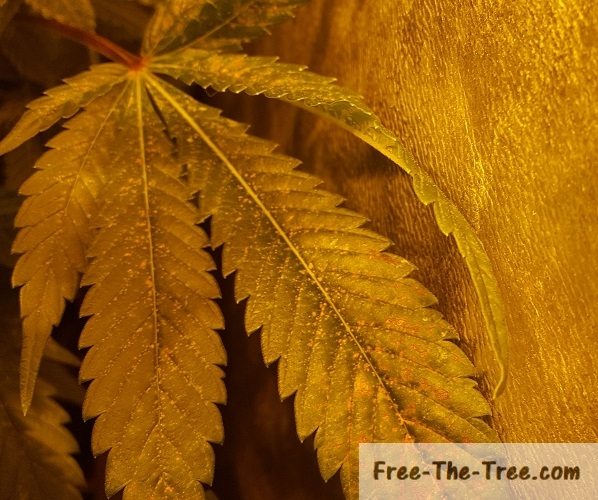
First Signs of Calcium Deficiency
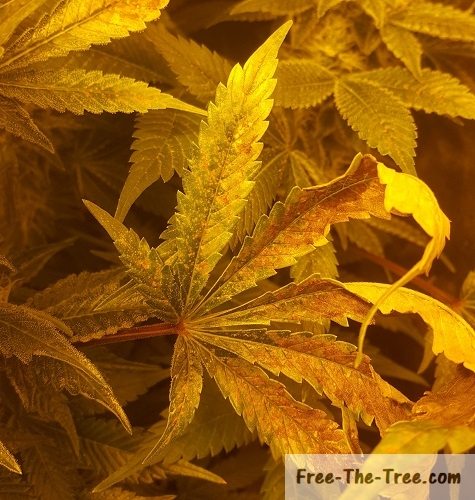
Severely affected leaf
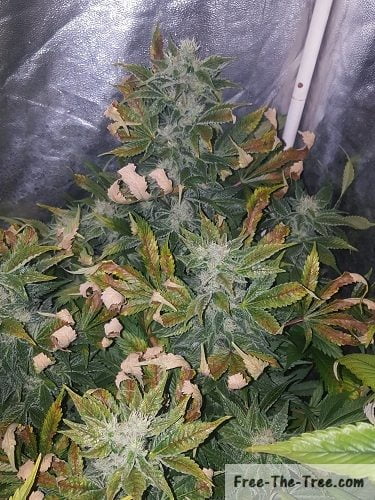
Calcium deficiency severely attacking the Big Buddha Cheese
As you can see in that last image this went pretty quick. The first signs on clean leaves started showing up at the end of last week and it went so fast.
As an emergency we sprayed the plants foliage with a Calcium enriched solution and in this weeks watering. Hopefully she’ll recover quickly but since Calcium is an immobile nutrient it’ll take about a week for it to get from the soil to the foliage.
Alright folks that’s it for this one!
Before we leave you here’s a coupe pictures of the plants this week 🙂
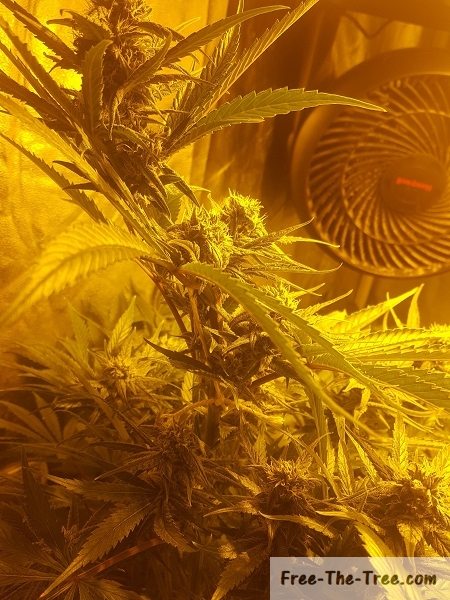
Super Cropped Cheese plant growing nice flowers
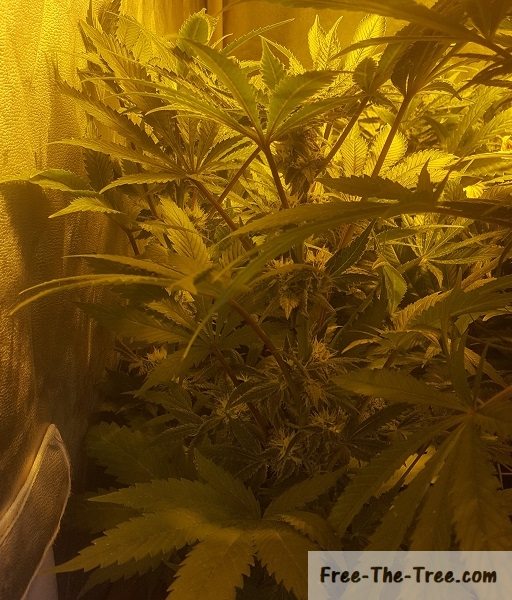
Bottom section of Blue Thai developing beds
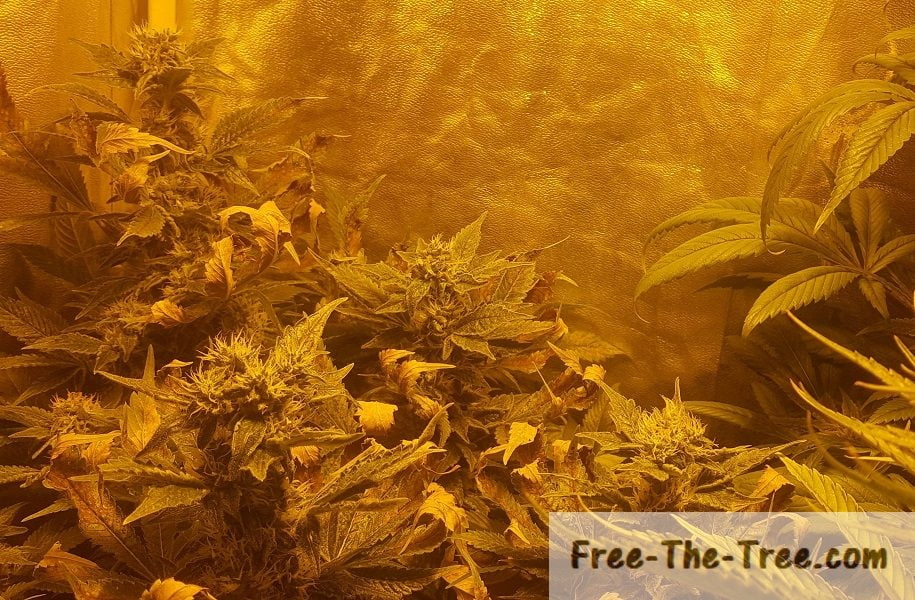
Big Buddha Cheese a bit ahead in development
Until next time,
Be safe and grow easy!
Don’t want to go yet? Check out our other Grow Reports
Check out all our Indoor Growing Tips
Hey there and welcome our weekly grow report!
Here we are in the 5th week of the flowering stage and it hasn’t been much of a smooth road ^^
That said, these babies are still looking pretty nicely, their smell is getting stronger and stronger and seeping into the rest of the house.
This week was actually a pretty smooth one and we were able to get some preeeetty awesome pics hehe, lets get into it 😉
Trichomes fully formed
We’ve bee keeping a pretty regular eye on the trichomes all over the different plants and we’re pleased to see that they’re now globally all fully formed, still mostly clear no the THC production hasn’t started yet but things are looking nice 🙂
Here’s a couple pics, as always you can click on them to see the full version
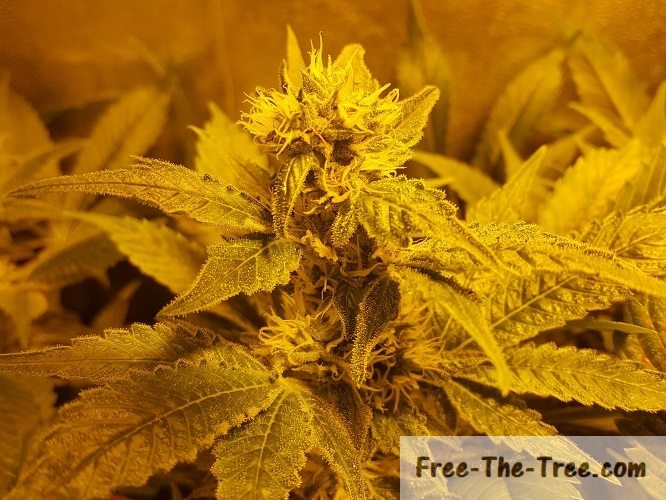
Flower full of trichomes

Close up on Pistils and flower trichomes

Close up on Pistils and flower trichomes
Aren’t these little things just beautiful? 🙂 In the picture all the way to the right you can see there full form and color, stem and the clear balled tip; those little guys will be full of THC soon enough hehe
Uneven Canopy
We’ve been saying over the past couple grow reports that a couple of our buds were too tall, especially the Cheese and, consequentially, the Blue Kush; We finally got some pics that really illustrate this disparity!
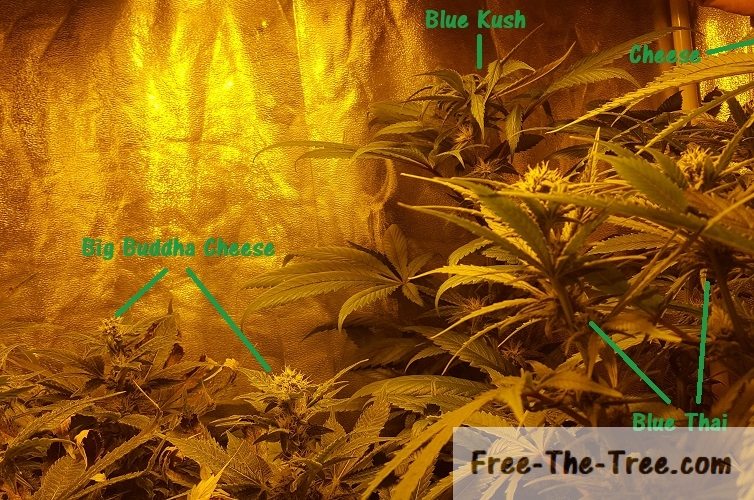
Huge Size difference

2 Plants much taller than the rest of the canopy
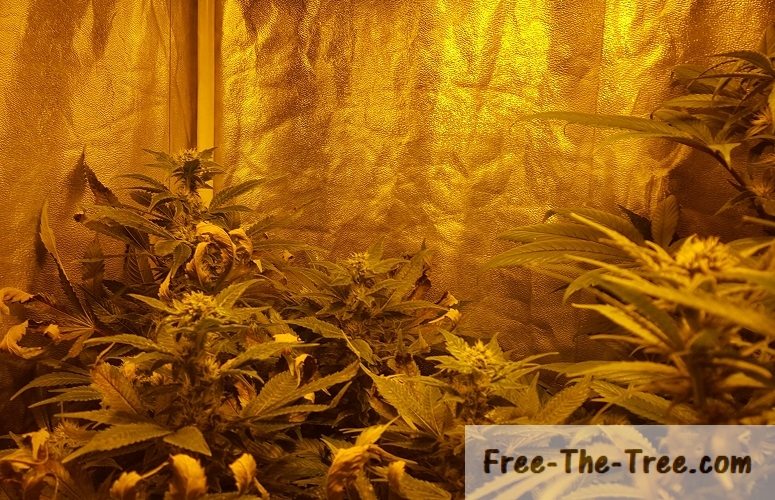
Big Buddha Cheese side is pretty even
Now keep in mind that cheese plant has been supercropped, she’s actually much taller than the Blue Thai next to her.
You can also see the Apex of the Blue Thai is suffering, looking all flat. I think it’s too hot for her so close to the hood so we decided to lift the right hand side of the hood as well as get the extraction hose near her in order to extract the heat right there.
Hopefully this will solve the issue..
Weed Buds developing nicely
This week the flowers have grown well, especially the Big Buddha Cheese.
As you can see in the images below Blue Thai is still between the buddlets to the flower, while the Big Buddha cheese is further along with long buds.
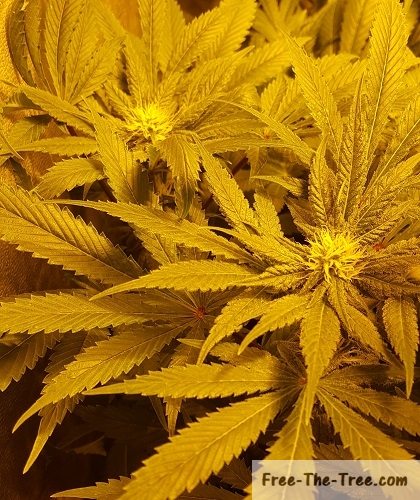
2 Blue Thai Buds developing
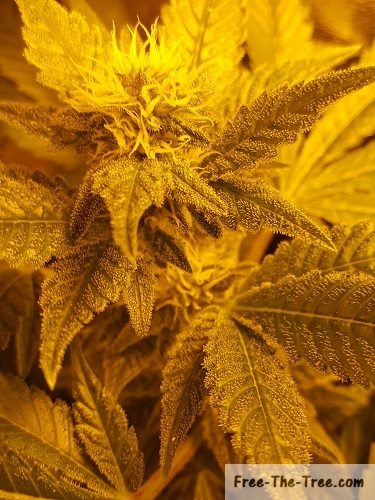
Big Buddha Cheese flowers and trichomes growing
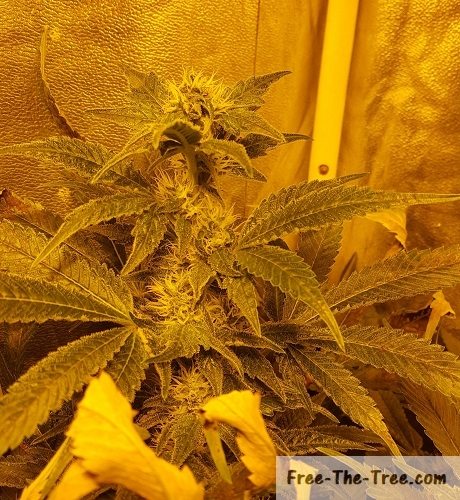
Main Big Buddha Cheese full of flowers
I think we’ll need to need to start flushing the Big Buddha Cheese a while before the other plants, which isn’t ideal since we’ve installed an automatic watering system.. We’re going to have to personalize it and set up switches in order to water the BBC separately.
Alright folks that’s all for this one!
Until next time, be safe and grow easy 😉
Don’t want to go yet? Check out our other Grow Reports
Check out all our Indoor Growing Tips
Hi There and welcome (back) to Free the Tree!
This past week we’ve seen some nice bud growth all around, although the BBC is still showing signs of Phosphorus deficiency… Hopefully we’ve added enough PK for them to be happy, and not too much for the others..
You can also see that Cheese plant was really getting too tall and close to the light source, which we can’t really raise much more than it is or else the Big Buddha Cheese and Blue Kush won’t have enough light.. So we decided to fold her Apex.
This is the first time we’ve done so many different strains at once and I think we went a little too far by having 5 different ones in there;
Furthermore, the BBC’s are mainly in re-used soil, maybe even dating back 4 grows, I think it may be totally out of nutrients and needs some time to recover..
Let’s get into it!
Phosphorus deficiency
If you read last weeks post you’ve seen that we’ve been dealing with phosphorus deficiency issue showing up so at your last watering we pumped up the amount of PK in the solution.
Since then we haven’t seen new leaves being affected by this deficiency which is a good sign, hopefully it’s the last one of this grow..
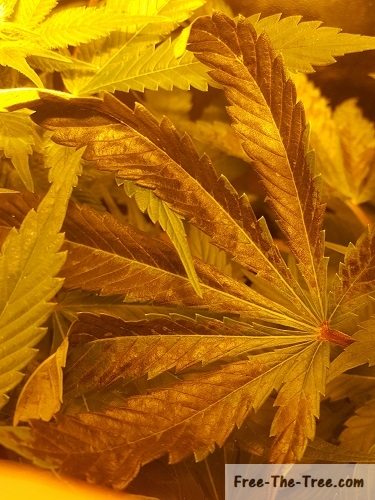
Leaves turned purple/black
Nice Bud growth
Although we’ve been seeing these deficiencies, over the past weeks the buds have been nicely developing, especially on the Big Buddha Cheese.
Her flowering cycle seems to be shorter than the 3 other plants, we might finish by harvesting her a couple weeks earlier 🙂
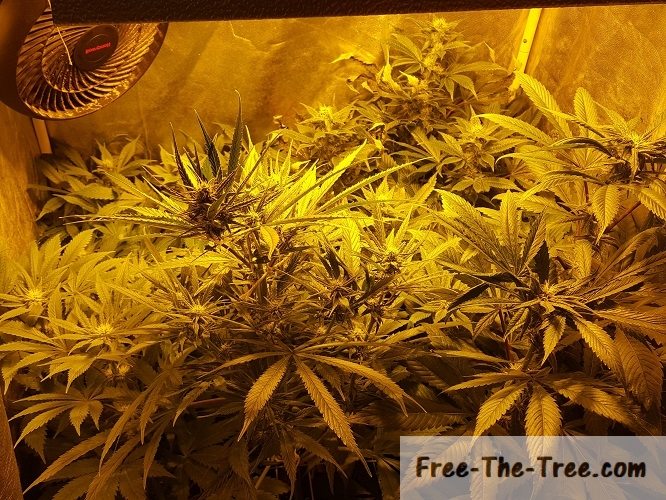
Buddlets developing into nice buds
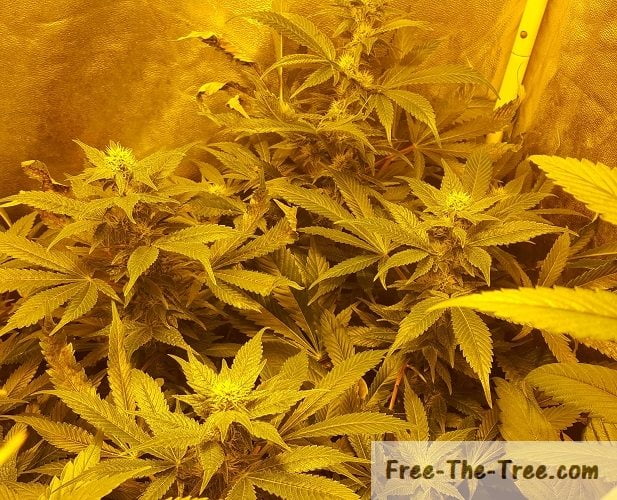
Big Buddha Cheese further along than the others
You can clearly see that the BBC is further along the road than her cousins in the room, her buds are looking sooo nice and their full of trichomes, really can’t wait to smoke up.
The smell has also been getting pretty intense, the whole room smells strongly, and when I open the grow room an even stronger odor is released, smelling beautifully sweat. It’s a real pleasure to see these little ones grow!
Apex Too close to the Light
Our cheese plant is the only one we didn’t weave on the screen since it was so small, at first. Now she’s way too tall messing up our whole canopy, make the Blue Kush stretch and is covering up the light of the blue Thai.
On top of all that she’s now way too close to the cooling hood and the Apex is starting to cook, really not an idea situation
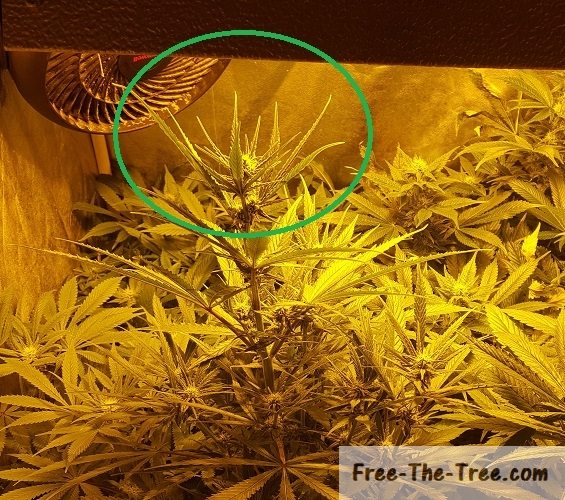
Leaves going vertical
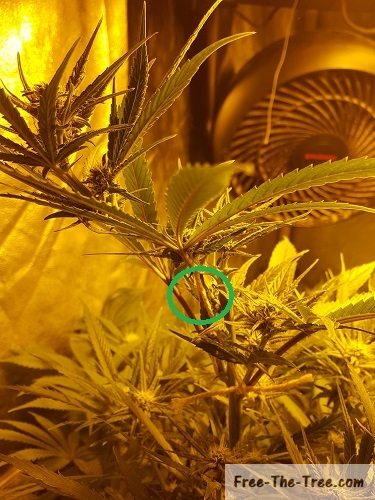
Super Cropped Apex during the flowering stage
Since we didn’t want to up the hood even more, making it too far for all the other lights, we decided to super crop the apex. Don’t really know what it’s going to give out, we’ve read left and right and there really all opinions about supercropping during the flowering stage.
Since it was divided we decided to go ahead and try it out. This little one will have been super cropped twice during this grow
I think that this will make her produce fatter buds lower within the stem and the top bud might be a little smaller and with less THC density, but… at least it won’t be all burnt up.
Alright folks that’s all for this one!
Until next time, be safe and grow easy 😉
Don’t want to go yet? Check out our other Grow Reports
Check out all our Indoor Growing Tips
Hey there and welcome (back) to Free The Tree!
This 3rd week of the flowering stage was pretty calm, we did our final pruning, removing the Cola’s that needed to go, our Big Buddha’s started showing some strong phosphorus deficiency signs and those darn thrips won’t die.. So yeah, not all that calm but we’ve had worst ^^
On a better note, the pistils have been growing like crazy, trichomes have been appearing all over the place and the smell.. oh they’re starting to smell up the room very nicely.
Let’s get into it
Pruning Marijuana during the Flowering Stage
About a day after the the end of the stretch we decided to go for a last round of pruning on the Big Buddha Cheese plants.
Since we scrogged them a massive amount of colas were present and most of them don’t cut it.
“They don’t cut it” means that they either have a stem wayyyy to weak, the flower nodes are spaced out too much or they don’t have a direct access to light source.
Either of these situations indicate that the cola will consume more energy than it can produce. This means that the cola won’t produce much AND take energy away from the other colas; For those reasons it’s best to let them go.
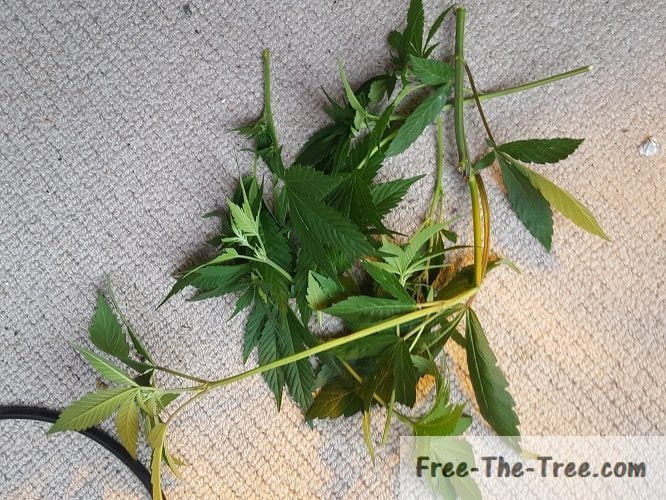
As you can see we didn’t prune that much this time around, but the colas we did remove are pretty long.
Most the colas could have been kept but their placement wasn’t optimal and had no direct access to the light source.
Since they were weaved on the screen we could of un-weaved them (carefully) so that they could reach the level of the canopy.
It’s actually what we did with some of the them, but these one’s we’re just in the way or too short.
Pistil growth and Buddlets appearing
Now that we’re really into the flowering stage the plants have been focusing their development on the flowers, and it’s been pretty visible.
Since the second week of the stretch trichomes have started to appear but they’re now growing much more and starting to form little budlets on the Apex of each plant.
From now on their just going to grow grow grow until they form some nice and dense flowers ready to be consumed 🙂
These next couple weeks are going to be really exciting, can’t wait ^^
(if you want to be notified for the next posts clic on the little bell on the bottom left)
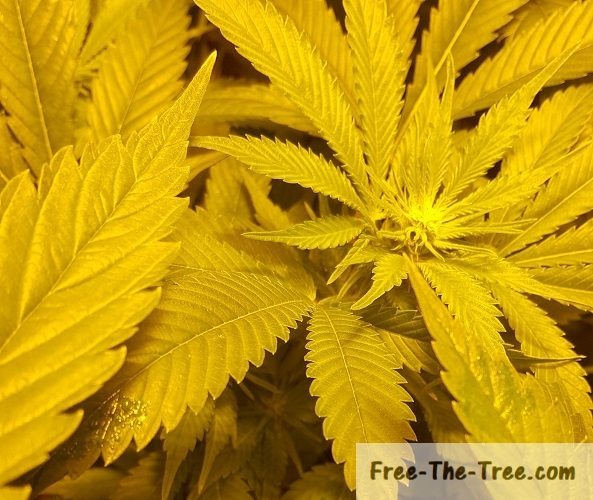
Pistils forming buddlet on Apex
Signs of Phosphorus deficiency on the Big Buddha Cheese
Since the end of last week we’ve been seeing the leaves of the Big Buddha Cheese plants starting to become brown, curl down and the most impacted ones are actually turning a purple/blue color..
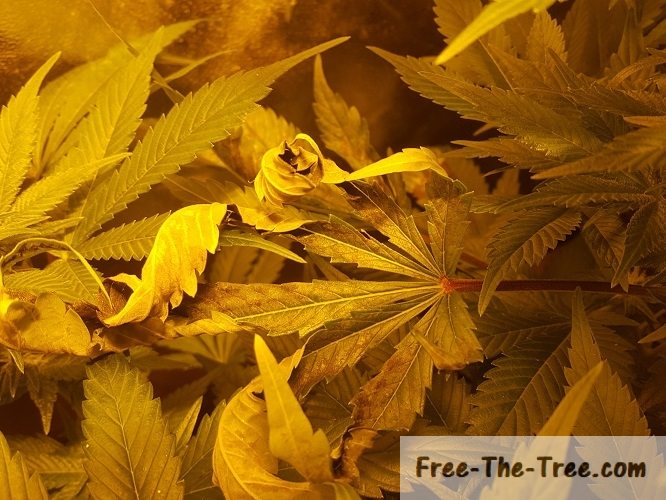
It took us a little while to diagnose what was going on, but as soon as those leaves turned black we knew.. Our babies can get enough Phosphorus.
Know we know that our pH levels have been between 6 and 7, meaning that the roots are able to extract it from the medium so that’s not the issue.
In order to solve this next watering we definitely need to up the levels of Phosphorus. Hopefully the other strains won’t get into a nutrient burn situation.. that would be one headache to handle
Couple Early Flowering Stage pictures
Since this week was mainly marked by deficiencies and pruning we figured it would be good to finish on a positive note, that is some nice pictures of them during this stage of flower growth, as always click on the image to get a full view.
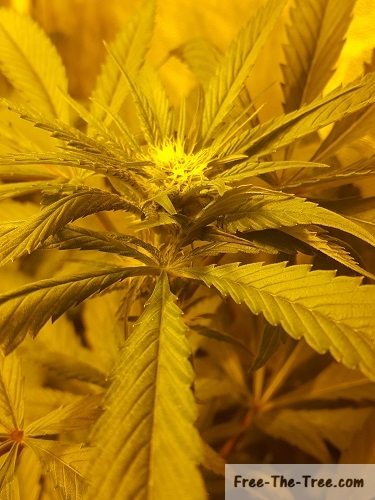
Apex Pistils growing
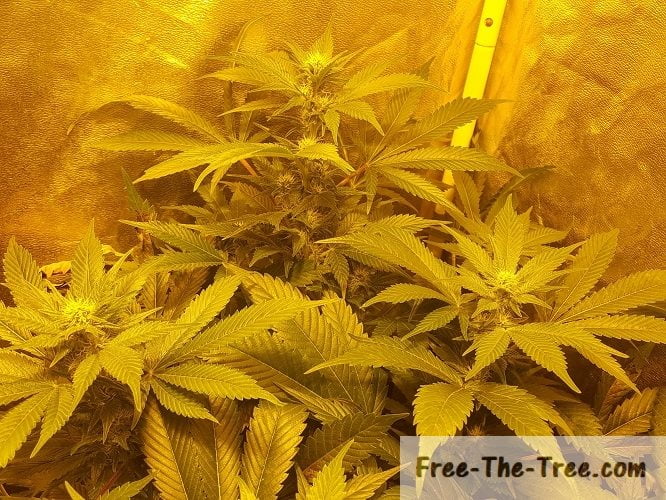
Scrogged BBC flowering
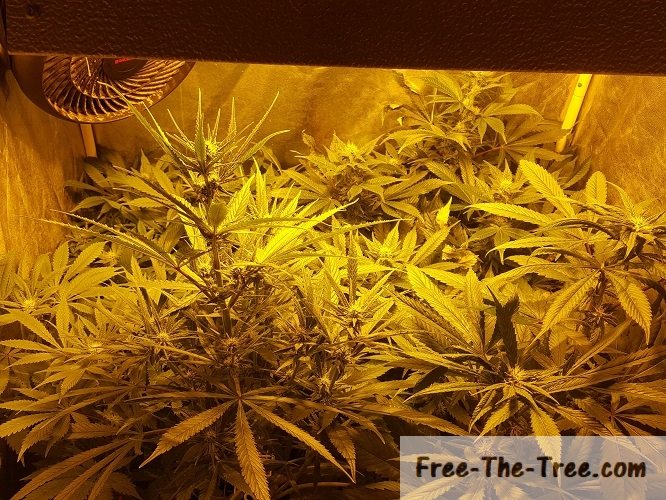
5 Strains flowering
Alright folks that’s all for this week!
Until next time, be safe and grow easy 😉
Don’t want to go yet? Check out our other Grow Reports
Check out all our Indoor Growing Tips
Hey there and welcome (back) to Free the Tree!
This week the flowering stage has officially started with the appearance of the first pistils 🙂
These 5 plants really grew a lot during the stretch, especially the Cheese and the Blue Kush (bottom middle and right) so we’re fighting an un-event canopy.. Apart from that they’re just beautiful!
Let’s go through the main events of the week, if you want to skip straight to a section here’s what we’re going to cover:
- End of vegetative growth
- Results of Super Cropping
- Automatic Water Run
- Switch to HPS lights
- First Pistils appear
End of Vegetative Growth
During this second week of the stretch we kept seeing strong growth across the board but, as we said in the intro, especially on the Cheese and Blue Kush strain.
Since the start of the stretch all the plants grew at least half their size except the Blue Thai. She’s a bit more shy which is a little bit of an issue canopy wise.
Here’s a couple pics of their evolution this week, as always click on them to see the full version.
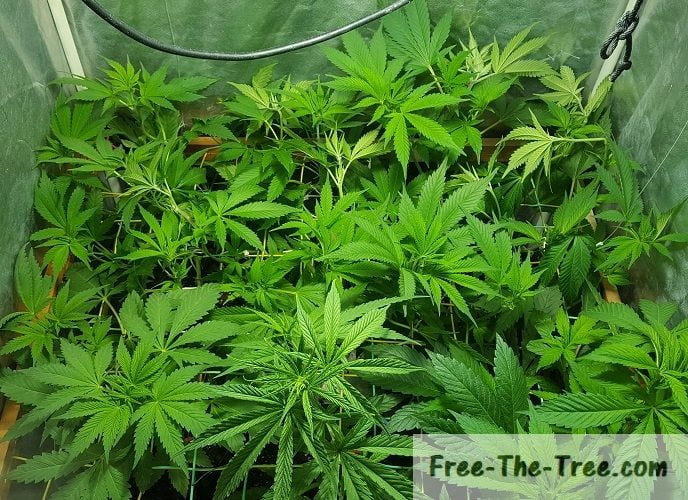
Start of the Second week – Room left in some area’s of the grow room
(Super Cropping just done)
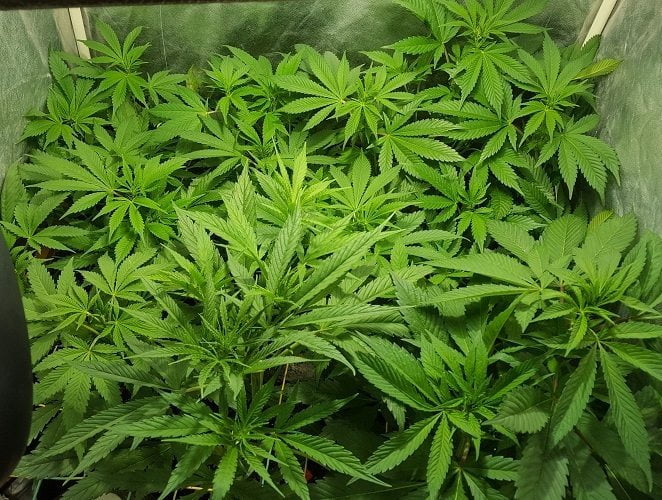
Mid way through week 2 – Grow Room is full
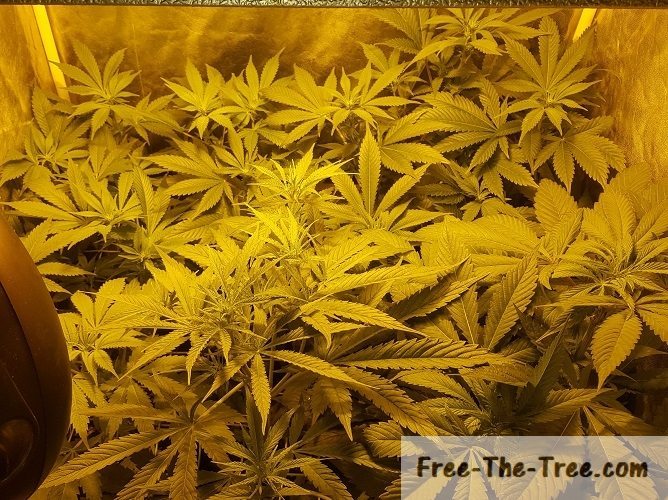
End of the Stretch – Vegetative growth has ended and first pistils are showing.
Just in one week it’s pretty crazy how much they’ve grown no? And compared to where the beginning of last week it’s even crazier! I love this plant haha
From now on they’re going to focus on developing those nice flowers that we love so much, some exciting weeks are ahead of us!
Results of Super Cropping
Last week and at the beginning of this one, we super cropped a bunch of the colas that were too tall.
There were 2 objectives for this, the first evening out the canopy, the second was so strengthen the stems and creating knots so the plant can store more nutrients within the stems.
Here’s how the Cheese plant reacted to it

Cheese plant super-cropped
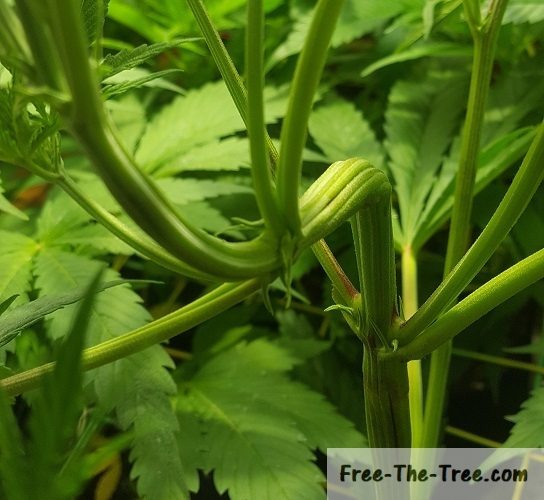
String holding stem removed a couple days later
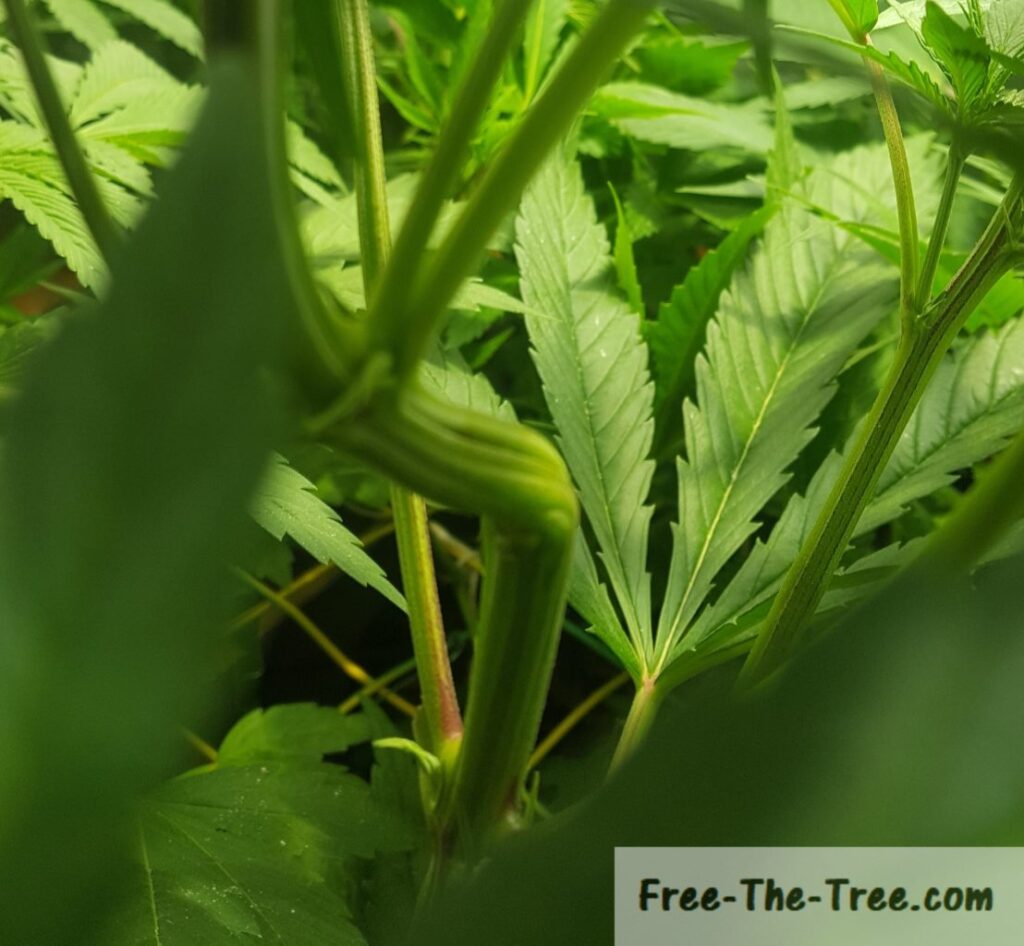
Colas standing back up – Knot starting to be visible
During the time that the main stem was super cropped the side branches grew massively, we pinched them a little so that they would strengthen also. I feel like this plant is going to give a niiice yield 🙂
Automatic Watering
We haven’t mentioned this in our previous posts but for the past month or so we’ve been watering our plants with our home made drip system and honestly it’s been wonderful!
It takes about 5 minutes to prepare the mix and then the the drip system waters the plant. We’ve been serving about 13L of water over about 6 hours of time. No water loss and the medium is well irrigated, the plant’s have been loving it! and honestly, so have I.
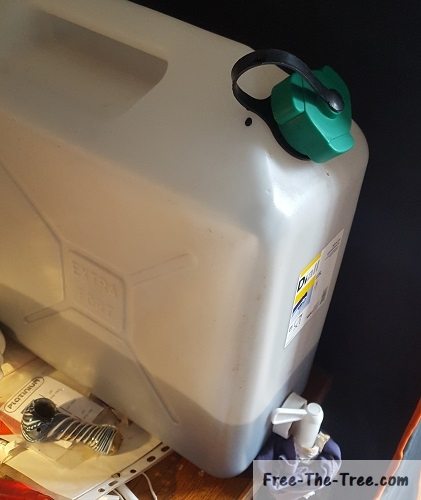
Water and Nutrients flowing into the grow room
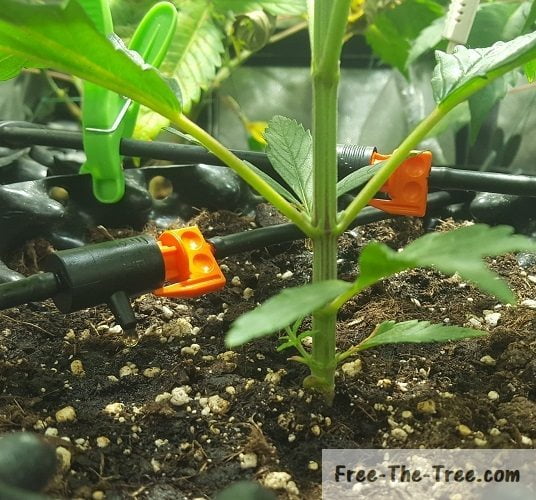
Drips slowly irrigating the soil
With this system in place, I don’t have to choose between taking the time to water them well (about 2hours) or quickly water them to be able to get back to business or whatever. We’ve done the later many times in our previous grows and you can definitely tell on the plant when the soil isn’t well irrigated.
It’s a win-win, I save time and the plants get a nicely watered and nutrient full soil on a regular basis.
Changing to the Sodium Bulb
I think this time around we waited a little too long to change from the Metal Halid bulb.
This time around we changed it the last day of the stretch, which might explain why we haven’t seen any pistils until now.. Next time we’ll definitely get it in there at the beginning of the second week of the stretch in order to avoid over-vegetating our plants.

Changing from HP to HPS bulb
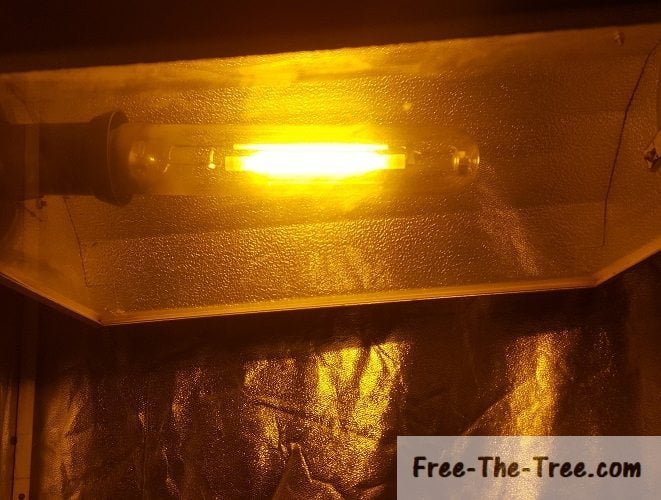
High Pressure Sodium bulb installed in an Air Cooled Hood
First Pistils appear
We’re finally in business! About 2 weeks after changing the photoperiods to 12/12 the bud sites have clearly showed up 🙂 How exiting!
This time around it really took them a while to grow, which I know for a fact isn’t normal for the Big Buddha Cheese and the Blue Thai. I really think it’s linked to the change in light, since the redder HPS light pushes the plant to flower.
Here’s a couple pics of these first signs of the flowers
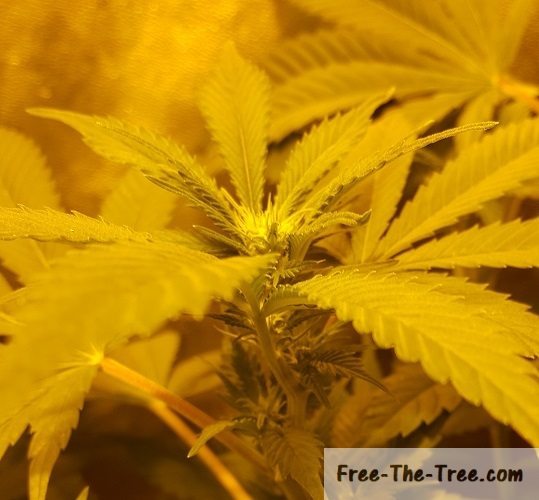
First Apex pistils growing

First pistils of another colas appearing
Alright folks that’s all for this one!
Until next time, be safe and grow easy 😉
Don’t want to go yet? Check out our other Grow Reports
Check out all our Indoor Growing Tips
Hey there and welcome (back) to Free The Tree!
This week we finally started the Stretch 🙂 The Potassium deficiencies we were seeing totally stopped spreading which means they now have sufficient levels so we’re good to go!!
On the top picture you can see that out canopy is far from being even which isn’t great, we’re planning to do some FMIing and pruning during the stretch to get that all evened out 🙂
Here’s what we’re going to cover:
- Starting the Flowering Stage
- Vegetative growth during the Stretch
- Pruning branches and leaves
- Super Cropping the top colas
18/6 to 12/12 – Starting the Flowering Stage
In order to get the flowering stage going we need to change the photo-period from 18 hours of light to 12 hours, triggering the wanted change in behavior.
All we’re doing by changing the light cycle is imitating nature, where by the end of the summer the number of daylight hours start being as close as the number of night hours.
The most important thing here is to make sure that they’re in full darkness during the night hours, irregular lights may produce hermaphrodites, which no-one wants (except for seeds)
The days after you change the light period you’ll see your plants starting to grow strongly. By the end of the first week some pistils should also start appearing.
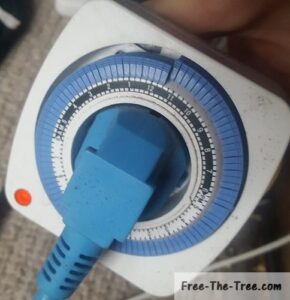
Mechanical Timer for Photo-period control
Week 1 of the Stretch – Strong Vegetative Growth
Over just 7 days they’ve all grown a whole lot but I think the most impressive is the Cheese plant, she’s doubled in size which is pretty cool since she was the smallest plant.
It might just be a visual thing though, since she only has 1 main coals whereas the others have multiple.
Here’s a couple pictures of the stretch

Day 0 – Tonight the light will shut off earlier
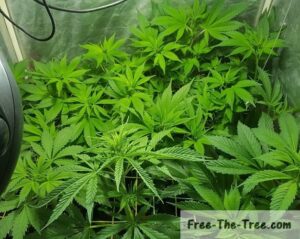
Day 6 – Strong Growth, grow room is full
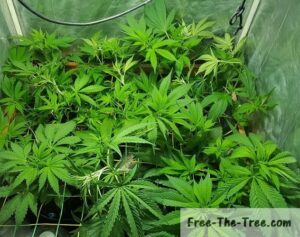
Day 7 – FMIing, Pruning and Pinching
On day 6 and 7 we decided to start pruning a whole bunch of branches and leaves (mainly branches).
Let’s get into why we did this
Pruning leaves and branches during the Stretch
Since there was such a strong growth during this first week we decided to go for a round of pruning on the 2 Big Buddha Cheese plants.
These 2 gals have produced just to many side branches. If we had kept them this way we would have a bunch of small buds instead of a nice and strong ones. In order to avoid this we’ve removed all the small branches that didn’t show potential.
Whether it’s because they had no direct access to light, better looking branches next to them had more potential or the bud sites were too far apart, they’re gone, without going overboard of course.
Here’s a couple pics (as always click on them for the full view)
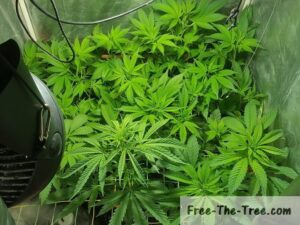
Day 6 – Before first round of branch pruning
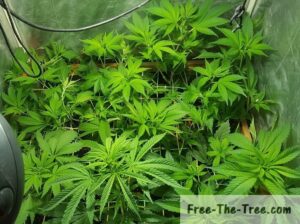
Grow Room after pruning

About 10 branches removed
There’s another reason for this pruning we didn’t mention above and this is the room around the Colas.
If you’re colas don’t have enough room around them they will basically race each other to the light source. This will make some lengthy and weak stems, which won’t be able to transport many nutrients, thus producing smaller buds.
You want the leaves of your different plants to overlap or touch as less as possible.
Super Cropping the top colas
As you may have noticed our Big Buddha Cheese plants are much, much bigger as the others and some of those cola’s are way taller than the others, which is an issues for the light balance..
In order to keep our canopy as even as possible we’ve decided to super crop the top Colas. This has 3 advantages
- Folding the cola reduces its height
- While she recovers growth will be slowed on that colas
- Once she recovers she’ll be able to store more nutrients within the stem.
We started writing a guide on super cropping : check it out if you have questions on super cropping weed.
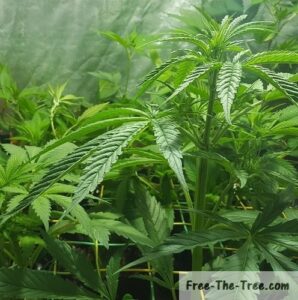
Cheese plant before super cropping
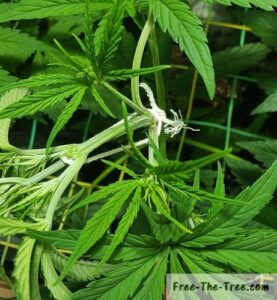
Apex Folded and tied horizontally
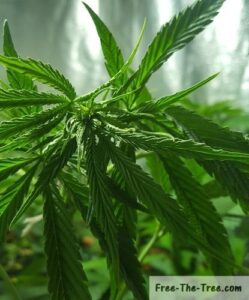
View of the Horizontal Apex
We repeated this process with every auxiliary branch that we decided to keep. She will be working at repairing these sections, making them more resilient.
Alright folks that’s all for this one!
Until next time, be safe and grow easy 😉
Don’t want to go yet? Check out our other Grow Reports
Check out all our Indoor Growing Tips
Hey there and welcome (back) to Free the Tree!
Today we’re going to cover the last week of the vegetative stage 🙂 within a little more than 2 months we’ll have some nice flowers ready to be harvested hehe.
These last weeks have been pretty full of events, between the Potassium deficiency, branch weaving and finally our 2nd attempt to do some cuttings off our Blue Kush.
Here’s what we’re cover in this grow report:
Let’s get started
Weaving the branches and Removing Leaves
During the vegetation station you’re going to need keep weaving the branches along the screen.
You’ll notice that some leaves are creating shade over some auxiliary branches. As long as the branch in question can handle it, remove the leaf in question.
Here’s our pruning run, as always click on the image to see the full version.
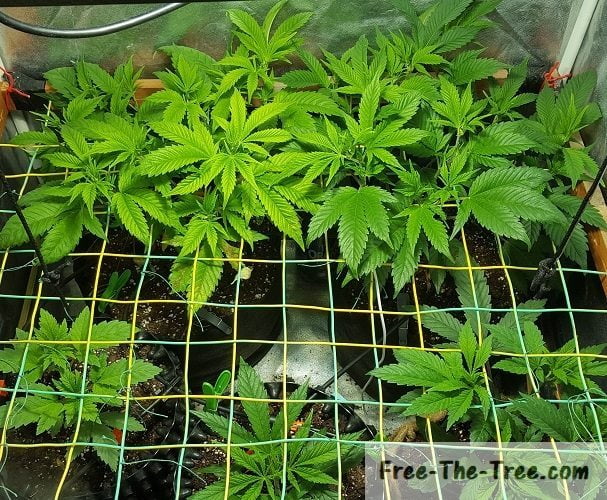
Before Weaving the Branches
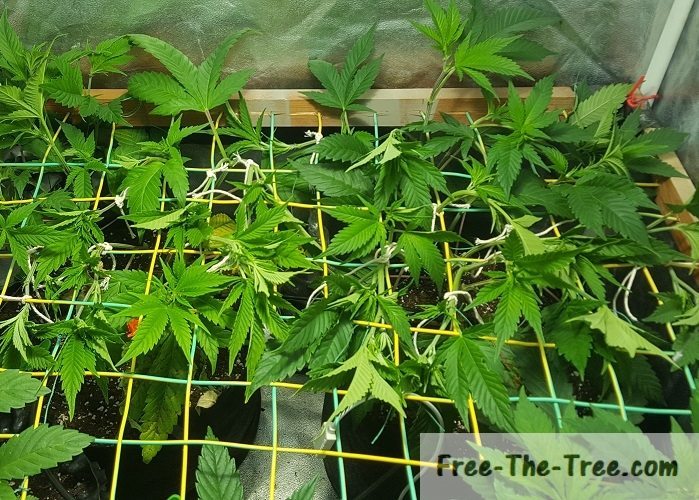
After weaving the branches
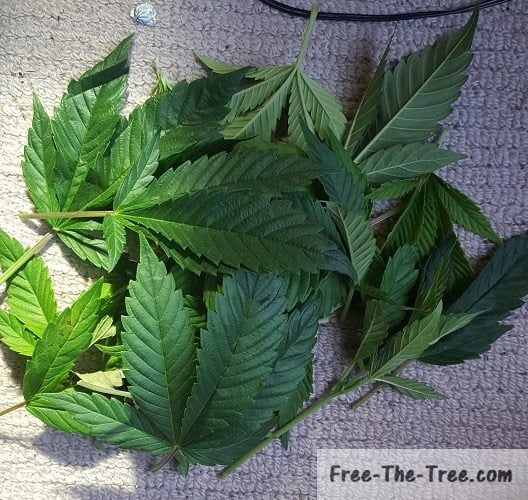
Leaves pruned in order to remove shading
Don’t hesitate on those branches, but do be careful not to brake any. If you do snap a branch use Duck Tape to repair it.
You might also think that removing those branches is counter productive, but exposing those auxiliary branches to will push them to develop as a main cola’s. Do be careful not to remove too many leaves though, you want to leave enough for each branch to do enough photosynthesis.
Potassium Deficiency Spreading
So this week the potassium deficiencies kept on spreading across the two largest plants.
We we’re actually expecting that it would keep spreading this week since we’re the bio grow range of products.
These products are “long term release” nutrients which means that they take about 7 days to release into the soil, meaning that the plant can’t get access to those nutrients for 7 days after introducing it to the soil.

Last Week’s Status of the leaves
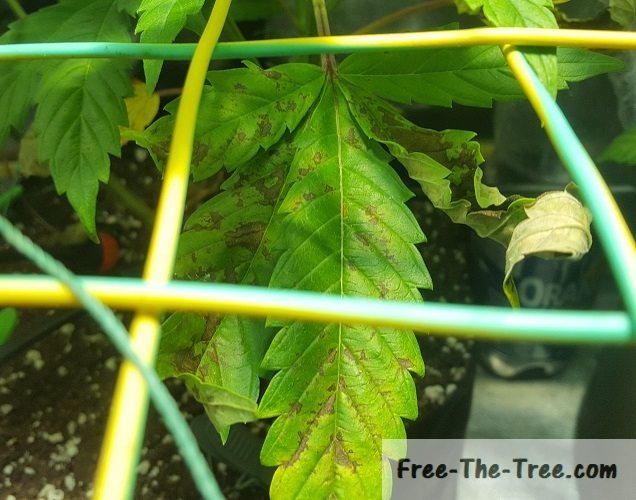
Potassium deficiency spreading

Leaf totally consumed by deficiency
Thankfully the deficiency stopped spreading to new leaves quickly so we only lost the couple leaves that were impacted at first.
As we bring forward in our guide, the only way to fix this is to add Potassium (K) the next time you water your plants.
2nd Try at doing Cuttings
If you’ve been following, about 2 weeks ago we tried doing some cuttings of the Blue Kush for one of our friends. Unfortunately that one died because we weren’t able to keep 100% humidity so she started sweating. Once that has started it’s basically over.
This time around our friend is transporting them as soon as we cut the branches.
We’ve covered in depth how to transport in our cuttings guide which we’ll link to further below but here’s some pictures of the process.
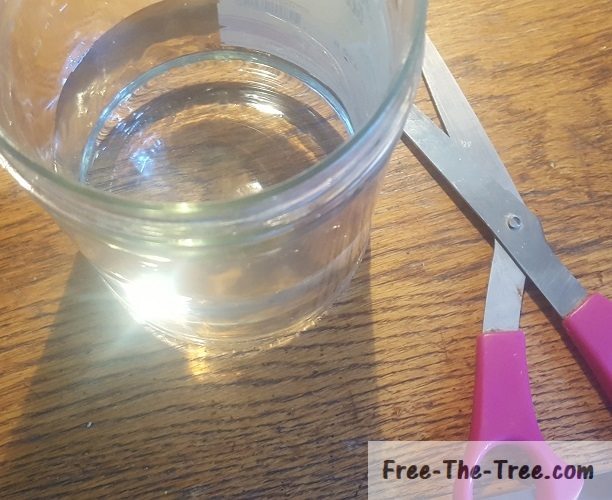
Jar half filled with water

Cuttings in the water
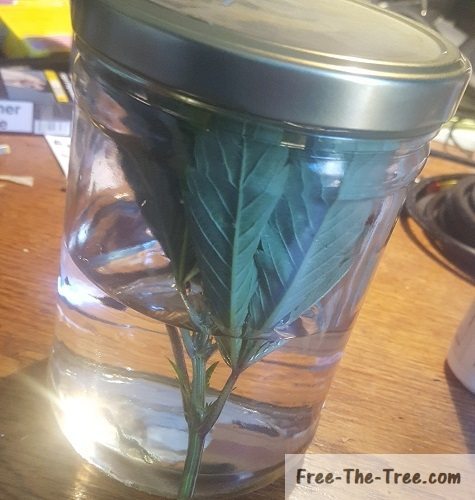
Closed Jar half filled water – 100% Humidity environment
Once the Cuttings are in the water and the jar is closed they’re ready to get going.
The quicker you get home and get them into the block of rock-wool the better the chance they’ll survive! (Don’t take risks driving though, better they don’t survive than you lose your life..)
Picture Evolution of Week 7
Before we go, here’s a couple pics of the grow room during the week. Next week we’re going to change the photo-periods in order to get the flowering stage going!

Start of week 7
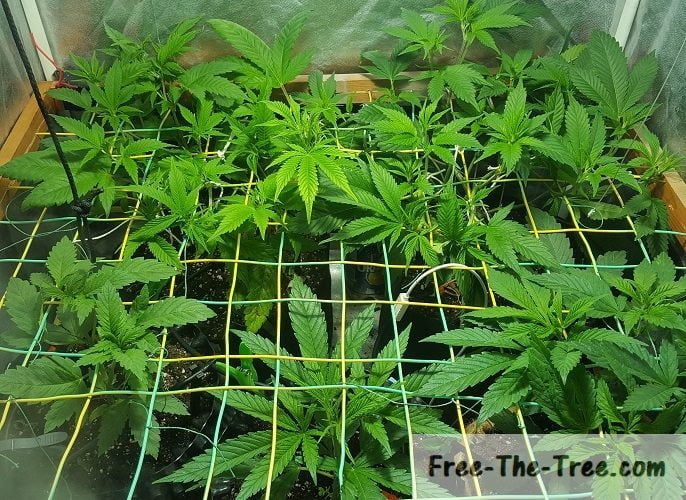
Mid way through the week

End of the 7th Week
Alright folks that’s all for this one!
Until next time, be safe and grow easy 😉
Don’t want to go yet? Check out our other Grow Reports
Check out all our Indoor Growing Tips
Hey there and welcome (back) to Free The Tree!
This week was pretty full of events, possibly too much to cover in just one post.
We kept on training our smaller plants for the ScrOG, did a cutting on the Blue Kush for a friend, started implementing automatic watering solutions and installed the Screen to start weaving the branches!
While all this was going on, our BBC’s started showing signs of Potassium deficiency and these darn Thrips keep on coming back.. pretty intense for just a week no?
Let’s get into it, but before that here’s some links if you want to go straight to the section that interests you.
- ScrOG plant Training (Part 2)
- Installing the screen of Scrog
- Signs of potassium deficiency
- Blue Kush Cutting
- “Automating” our watering system
Keep in mind that we won’t go into each section in depth, but we will link to our articles where we do cover these subjects in depth if you want to know more, let’s get started!
Plant Training Continues

As a reminder, at this point we had just recently cut the tip of the 2 new branches. Doing this increases the energy sent to the 2 side branches growing at the spot where the knot is.
We decided to stop here, but you can keep of cutting the tops at each new stage for her to keep dividing and producing more side branches.
Step 5 – Wait until the branches reach the screen
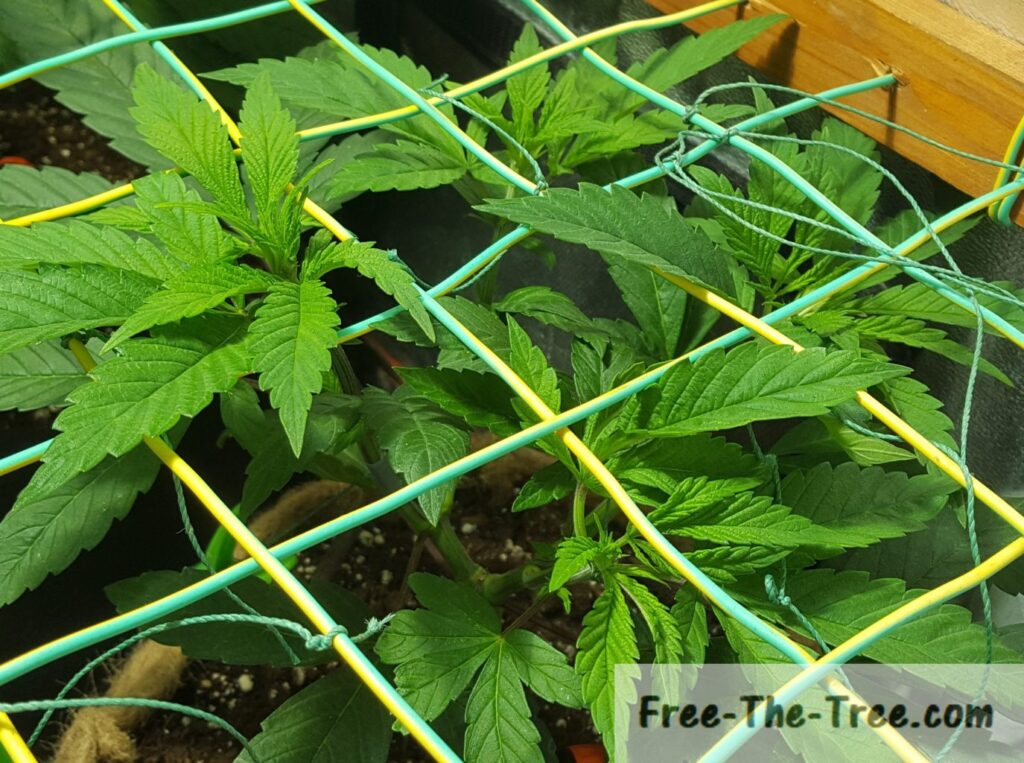
Once you’ve decided that you have enough branches you’re going to have to wait for them to grow up and reach the screen in order to start weaving the branches.
You should try and pass the branches and leaves through the screen as soon as she can reach, this will push her to grow faster 😉
Step 6 – Weave the branches on the Screen.
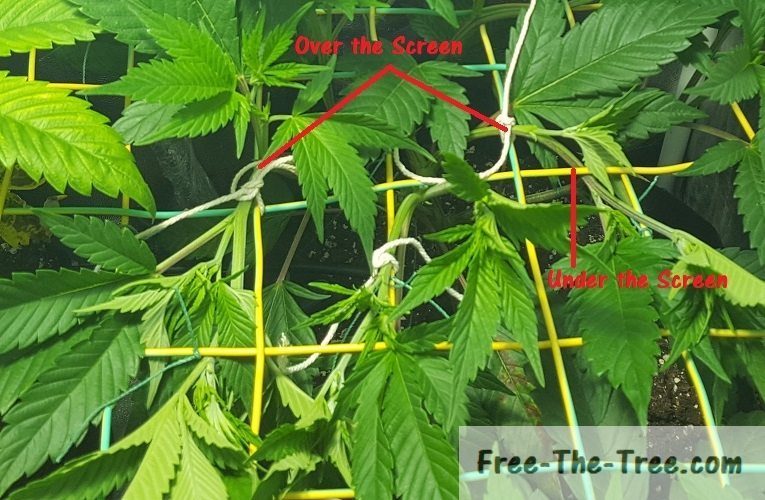
After a couple days your plant will have grown enough and will start passing through the screen. At this moment you’re going to want to start guiding the branches over and under the screen.
This will allow the plant to develop some more branches that will grow vertically, increasing even more your final yield.
Installing the Screen for the SCROG
Although half our plants aren’t really tall enough to weave, the Big Buddha Cheese plants so far ahead that we need to get them scrogging;
The main issue being the height difference between the plants, if we hadn’t done this, by the end of the stretch we would have to choose between light burn on the BBC’s of not enough light penetration for our other plants.. Hard decision.
To avoid this we started to weave the plants on the screen, and clipped any branches that are growing too high up.
We went in depth on attaching the screen over here if you want to get the step by step process.
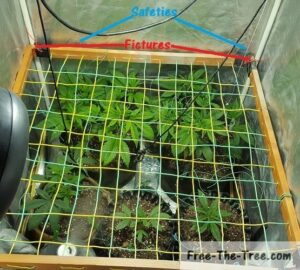
Screen attached in the grow room
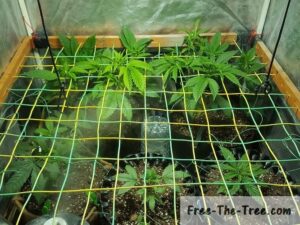
Screen lowered to Apex level

View under the screen
First signs of Potassium Deficiency
During this week one of our Big Buddha Cheeses plants started showing the first signs of Potassium Deficiency which isn’t cool.
We wanted to get the flowering stage started within a week, but since Potassium is one of the Nutrients that push the plant to flower, we must solve this deficiency before doing so.
We did a full guide on potassium deficiency, linked below, but basically in order to solve this issue you need to increase the amount of potassium given to the plant during the next waterings.

Making a Cutting from the Blue Kush
I don’t know if you’ve noticed in the previous posts, but we had kept a strong side branch the whole time without ever mentioning why.
The reason behind this is that we want to make a cutting from it for a friend so that he can have one of these beauties also.
We’ll just put a couple pics of this cutting here, but check out our article on doing cuttings if you want to know more
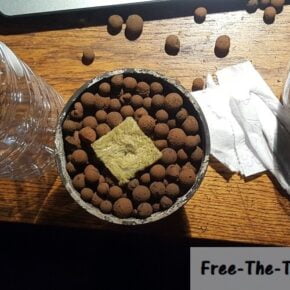
Tools needed to make a cutting
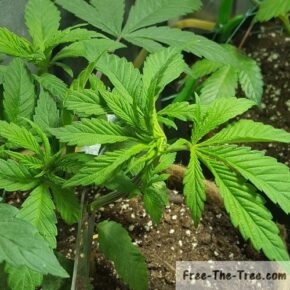
Removing the branch for the plant
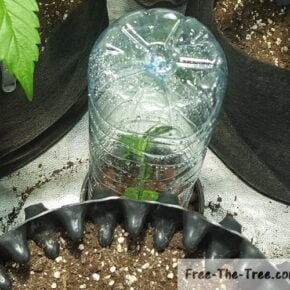
Cutting growing in the tent
Unfortunately this cutting didn’t take, we couldn’t keep the humidity level high enough for her, so she started sweating and died.
Once the plant reaches the screen we’ll prune the top of one of two branches in order to give it another run.
Automating the watering of Marijuana
Automating our watering system is really something we’ve been thinking about for a long time since it’s so time consuming. On top of that, this time around we’re using much bigger pots than before, meaning even more time to water… And honestly, we just didn’t have the time anymore to do it well.
We tested different techniques, that we’ve grouped together over here.
We’ll only show you our final setup that is now fully functional, saving us a looot of time

Watering mix in the container
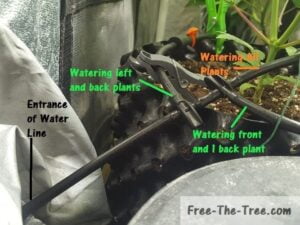
Water line entering the room

Drip System watering the plants
On top of saving time, this type of system actually waters your plant much more efficiently. Since the water flows much slower it irrigates the soil by capillarity, spreading much better across the medium.
This means 2 things:
- The roots receive more water
- You use less water at each watering (no need for the 20% run-off
Alright folks that’s all for this one!
Until next time, be safe and grow easy 😉
Don’t want to go yet? Check out our other Grow Reports
Check out all our Indoor Growing Tips
Hey guys and welcome (back) to Free The Tree!
This week is pretty weird. On one hand we’ve got 2 plants that are growing real quickly (the 2 BBC’s) and 2 plants growing reeeal slow (cheese and Blue Thai). We’re already trying to figure out how we’re going to deal with the different sizes in time in order to avoid issues during the flowering.
That said, in this post well go over the plant training that we did in order to prepare for the SCROG, as well as the reasons why these two little one’s have been growing slowly.
Let’s get into it!
Training Marijuana Plants for ScrOG
Setting up your ScrOG is something you need to prepare for pretty early on in the life of your little one. I’m not saying that you can’t decide later on, but the best moment to start training your plant is at the 3rd stage of leaves.
Little pointer before we get into it, we won’t have the last step on the training since it takes a little more than a week to grow. The last step will be in our next post 😉
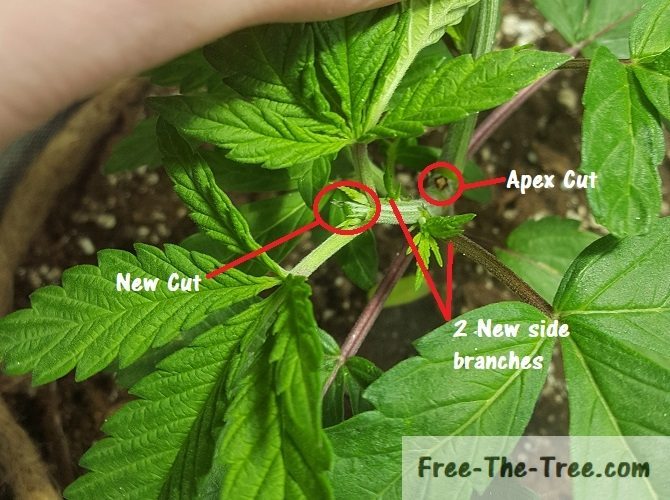
Training Weed for a Scrog Easily
So we’re going to go through each step in order to train your Marijuana for a scrog.
As a reminder, these are the steps before setting up your screen. If you want to go to the screen set-up check out our ScrOG guide.
The first picture will show the plant just before we started to train her, after which we’ll get into each step.
Plant 1 – Young Blue Kush Weed Plant

You want to wait until the 3rd stage of leaves before doing anything. In the picture above we must wait a little before starting to train this one.
Step 1 – Pruning the Apex
Once your plant has grown her 3rd stage you’re going to want to cut (prune) the top section of the plant with a pair of clean scissors or a blade.
As we show in the picture below, you’ll want to do this just above the knot, be careful not to damage the side branches that are forming!
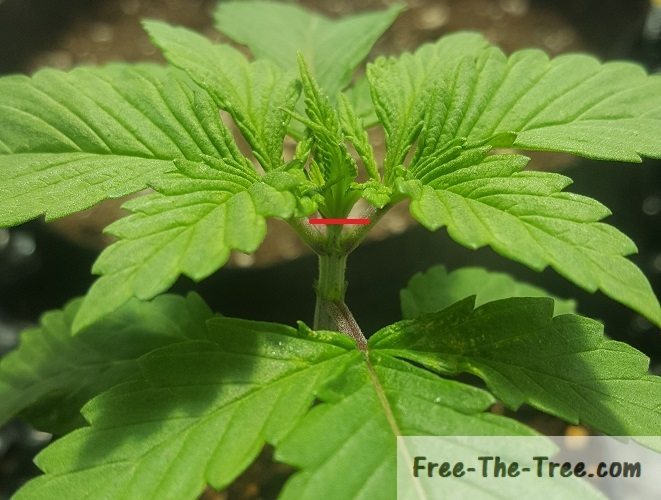
In the next step you will be able to see what it the plant will look like without the Apex. If you’re worried about the fact that the Apex is supposed to be her strongest and best bud, don’t worry, you’ll get that bud x10 😉
Step 2 – Let the 2 new Branches Grow
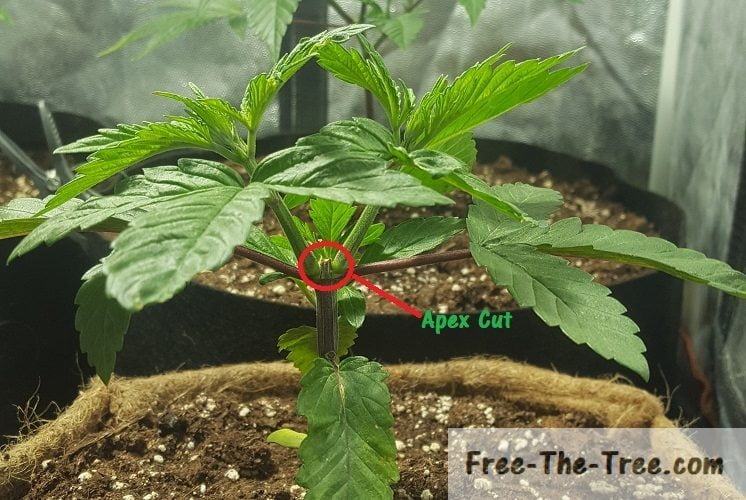
After cutting the Apex you’re going to want to wait until each side branch has developed a new stage of leaves.
Step 3 – Prune Tip of the 2 new branches

Now as you can see we waited a little too long to cut the tip of the side branches. Generally you’d want to cut it before the growth of the next stage in order to avoid any waste of energy. With that in mind, we’re still going to keep the 1st stage branches, in time we’ll prune the 2nd stage growths and that top leaf that’s shading the branch.
Step 4 – Let the new sets of branches grow

Once you reached this stage you’re going to wait a little until those 4 branches have grown enough to start training them. As you can see above, at this point in time they’re way to small to start doing so. We need to wait a couple days, so the second half of this section will be on the next post 😉
Slow Growth during the early Vegetative Stage
As we started saying in the beginning of the article, 2 out of the 3 plants originating from the germinated seeds have been growing really slowly, especially compared to the third.
After reading left and right, this is due to the fact that we planted them straight into the final pot, whereas the other plant was in a small pot before being transplanted into the final one.
We didn’t know this at first, but a weed plant in that it in a pot that’s too big for it will grow much slower since it’s focusing on root development. This means that the root system will be well developed, but there’s definitely some time lost.
Here’s a couple picture of the growth during this week.
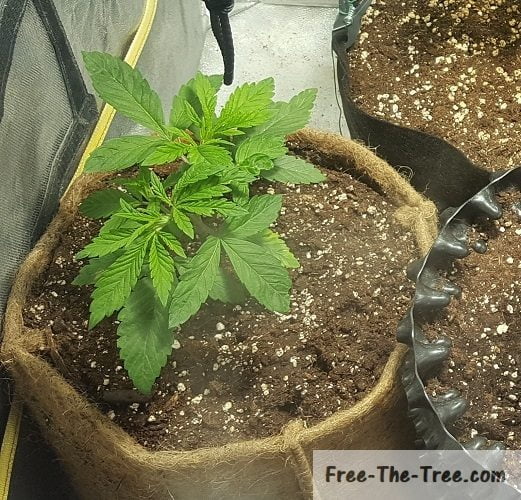
Normal Growth – Blue Kush planted in small pot than transplanted to larger pots.
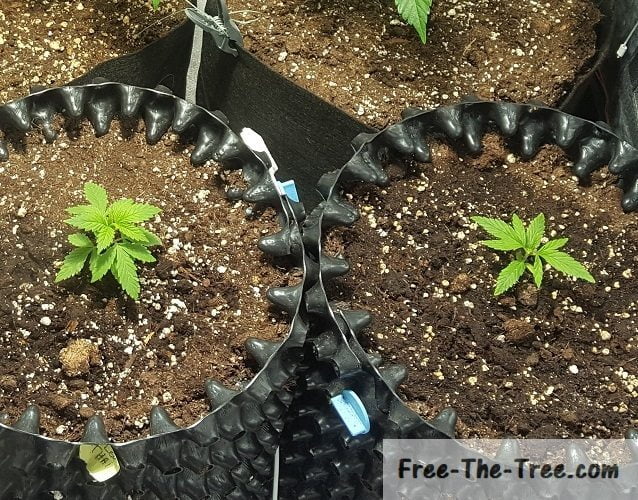
Slow Growth – Blue Thai and Cheese planted straight into the large pots.
Just with these 2 pictures you can easily see the huge difference. Keep in mind that these seeds germinated at about the same time! (couple days delay for the Cheese plant on the far right).
Crazy how big of a difference in growth there is no? Thankfully this week the 2 slower plants started getting there growing on, but they’ll never catch up the other plants.
As we said earlier, the reason for this is the fact that a marijuana plant that’s planted in a large pot will grow slower during the early vegetative stage.
On the upside, these plants won’t have any transplanting stress and once the root system is well developed they’ll get growing strongly.

Blue Thai – Apex just pruned for ScrOG preperation
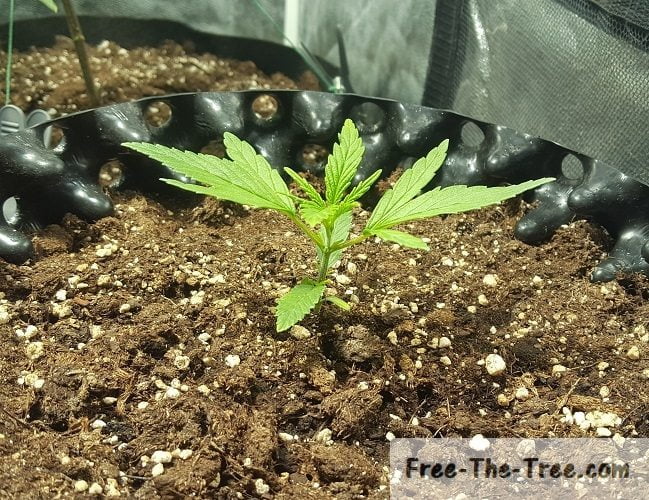
Cheese plant event smaller – 2nd stage of leaf growing
As you can see in the two images above, by the end of the second week they had grown “a lot”. The Blue Thai had grown the 3rd level of leaves so we decided to cut the Apex on this one.
On her side, the Cheese is still hanging back. We decided to cut all new side branches in order for her to focus on vertical growth.
I’m not too sure what we’re going to do with her, if she catches up we might do a small scrog, or else we’ll just keep a couple side branches and work her more when we get into the re-vegetation cycle (spoiler ^^).
Before we let you go, here’s a couple last pictures of them at the end of week 5, as always click on them to see the full picture.
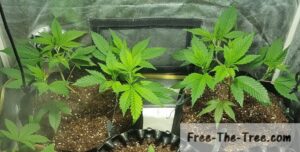
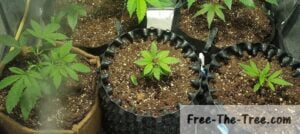
Hopefully these 2 little ones are going to get their grow on.. Next week we plant to make the cutting of the Blue Kush for a friend and place the screen, so they need to hurry up ^^
Alright Folks, that’s it for this one.
Until next time, be safe and grow easy!
Don’t want to go yet? Check out our other Grow Reports
Check out all our Indoor Growing Tips

